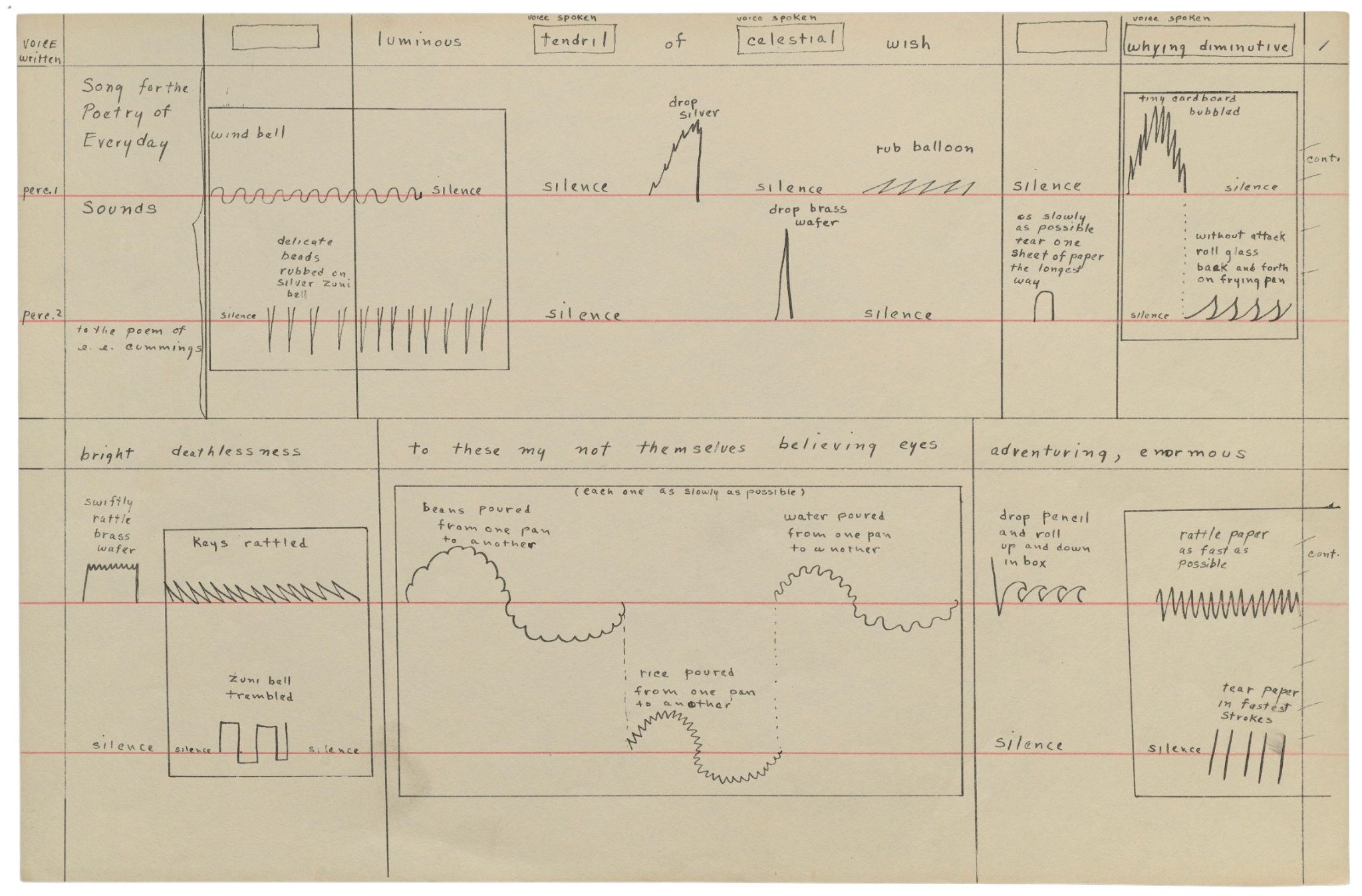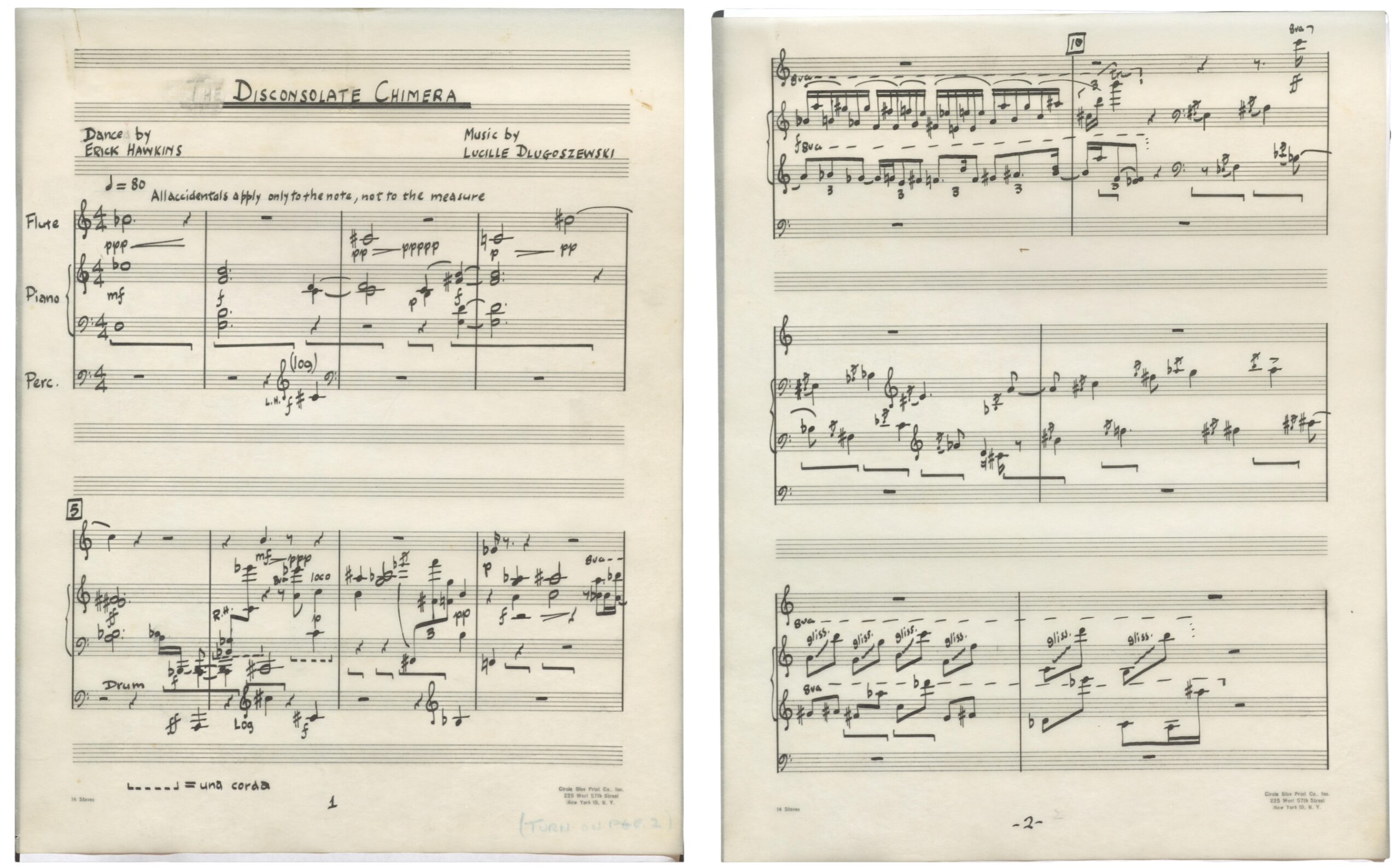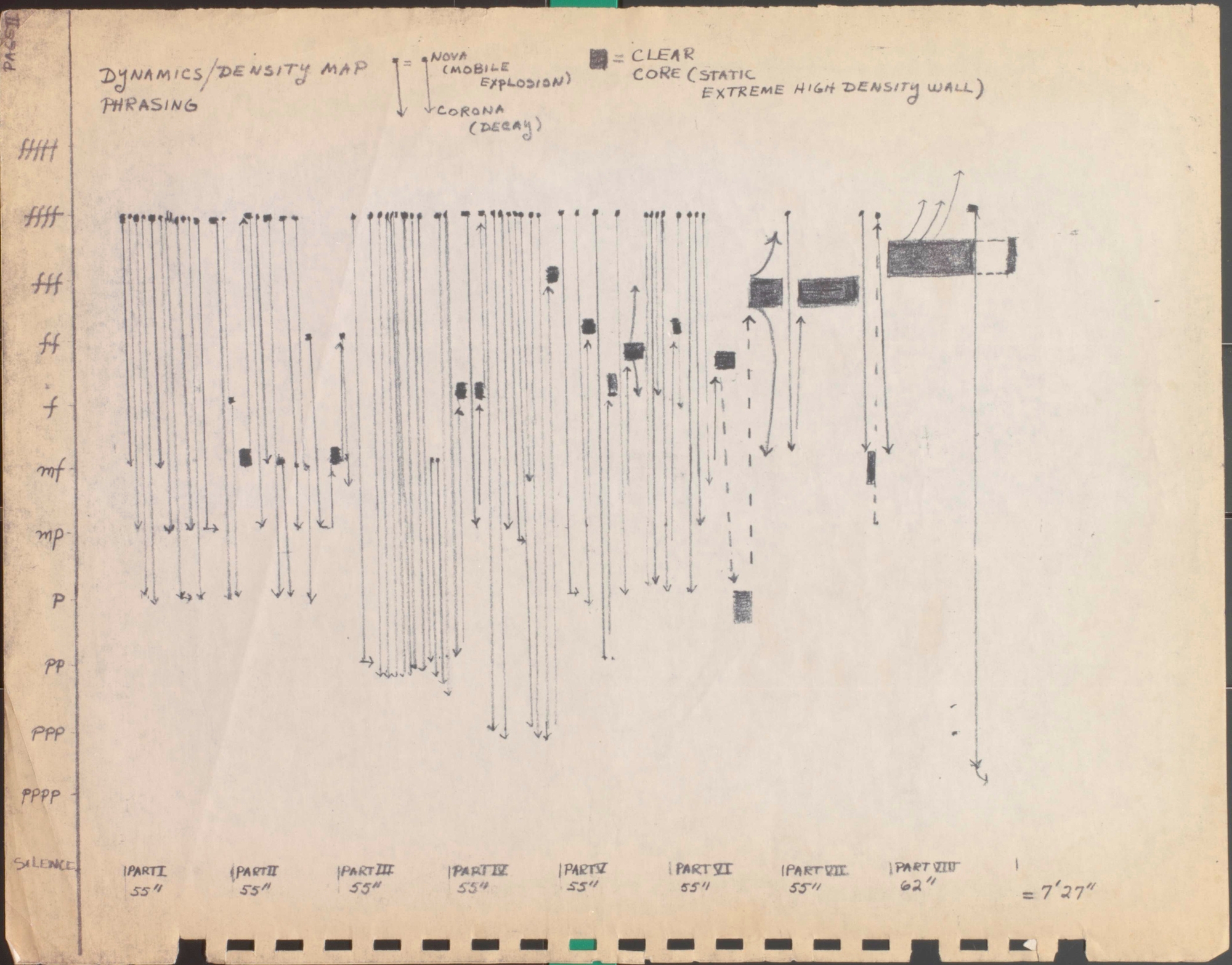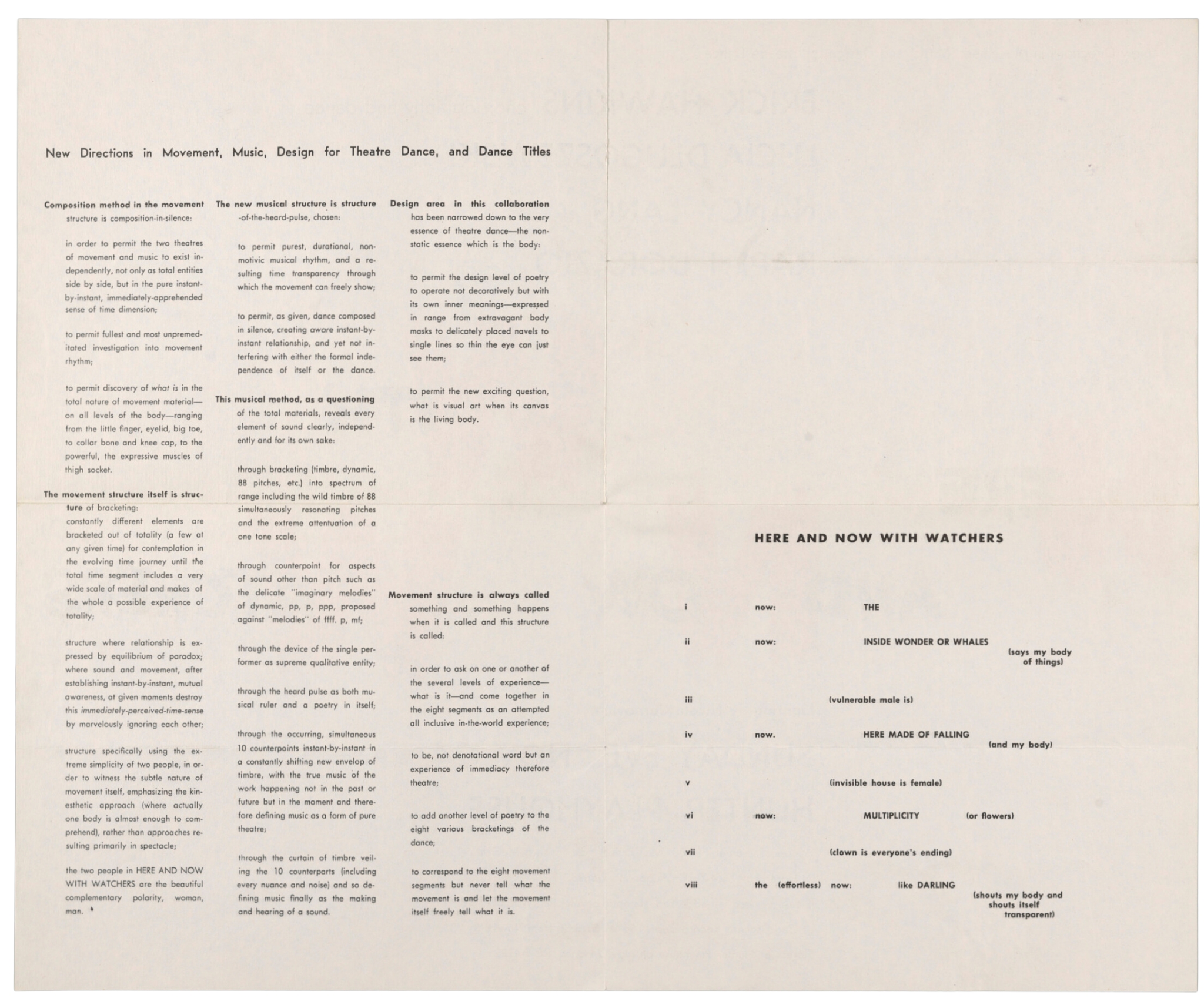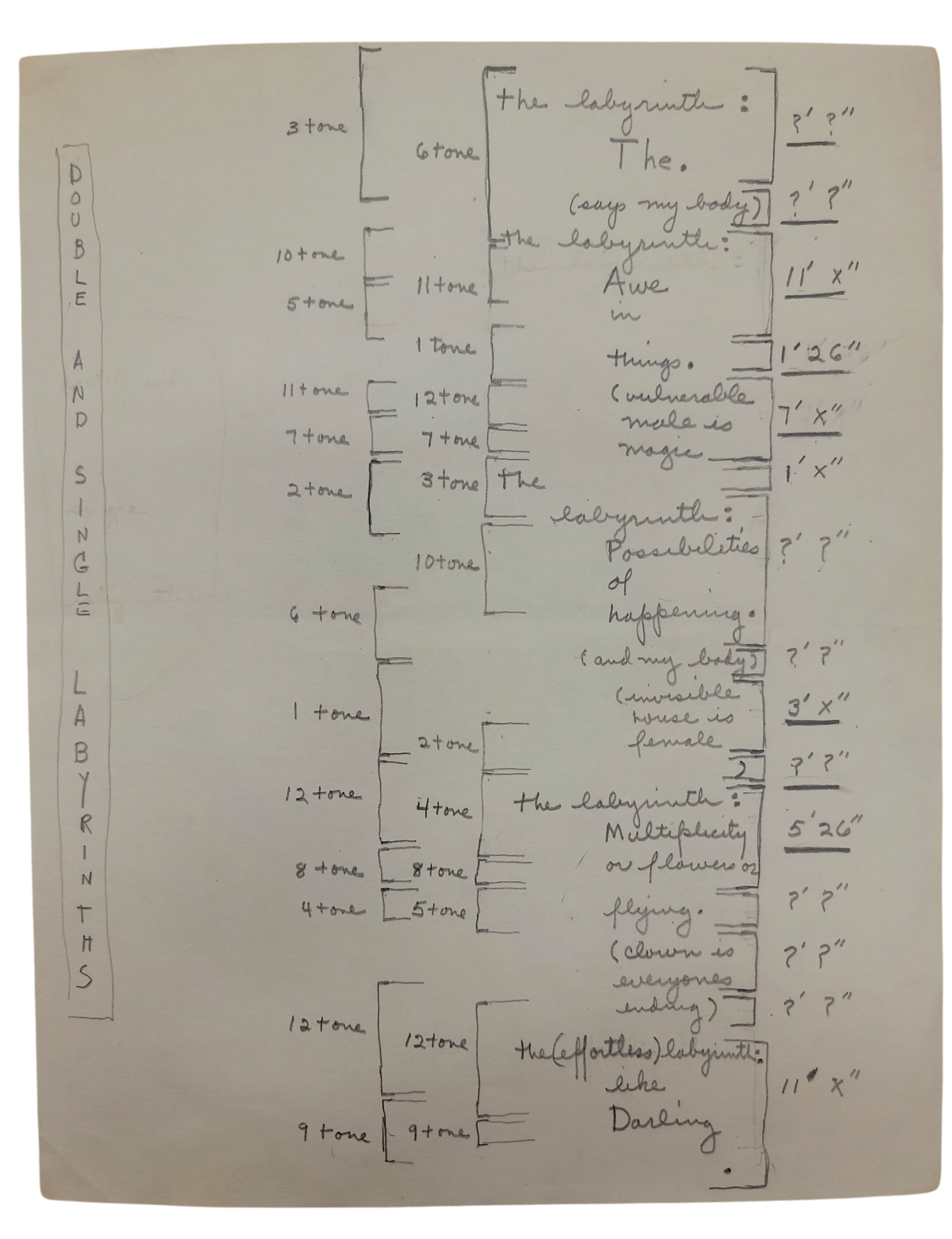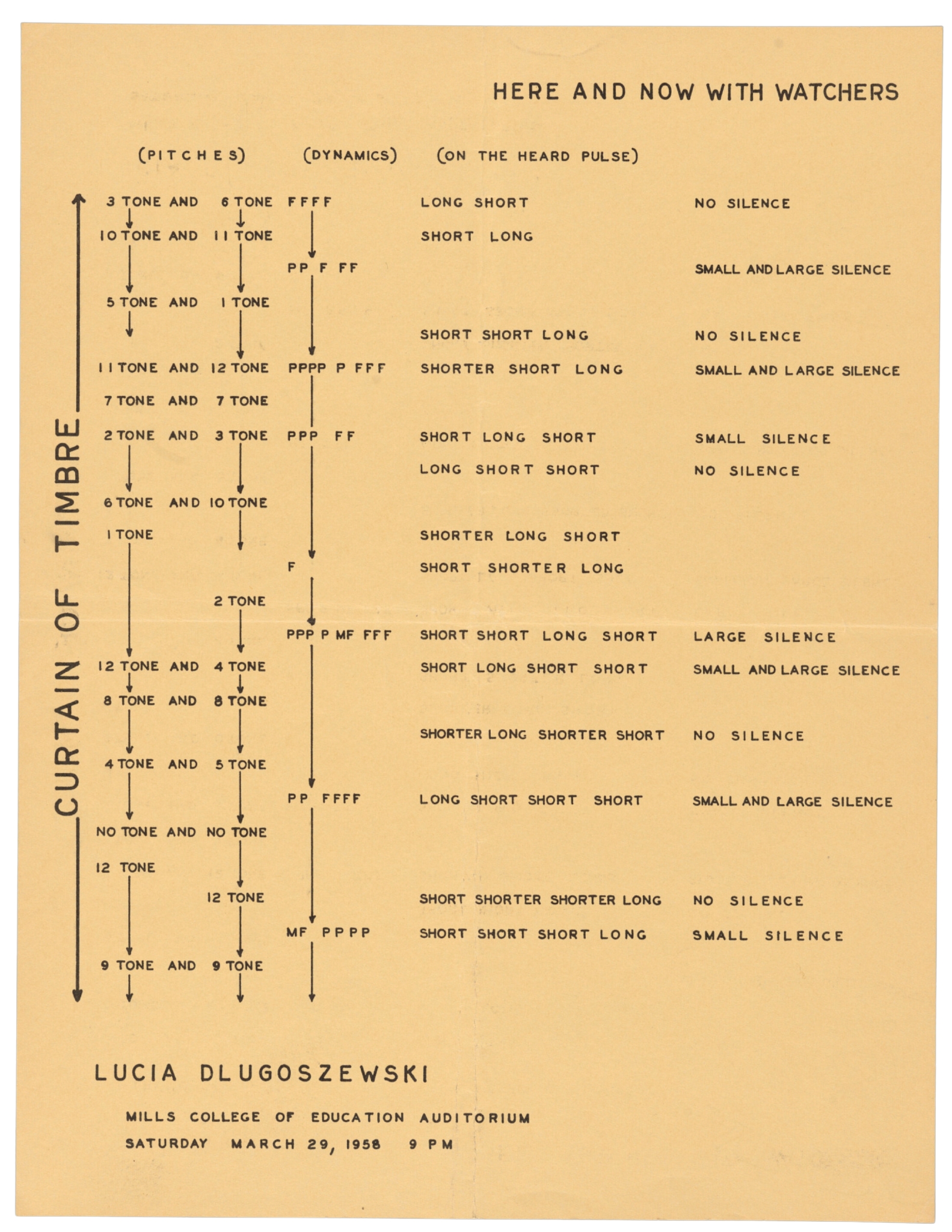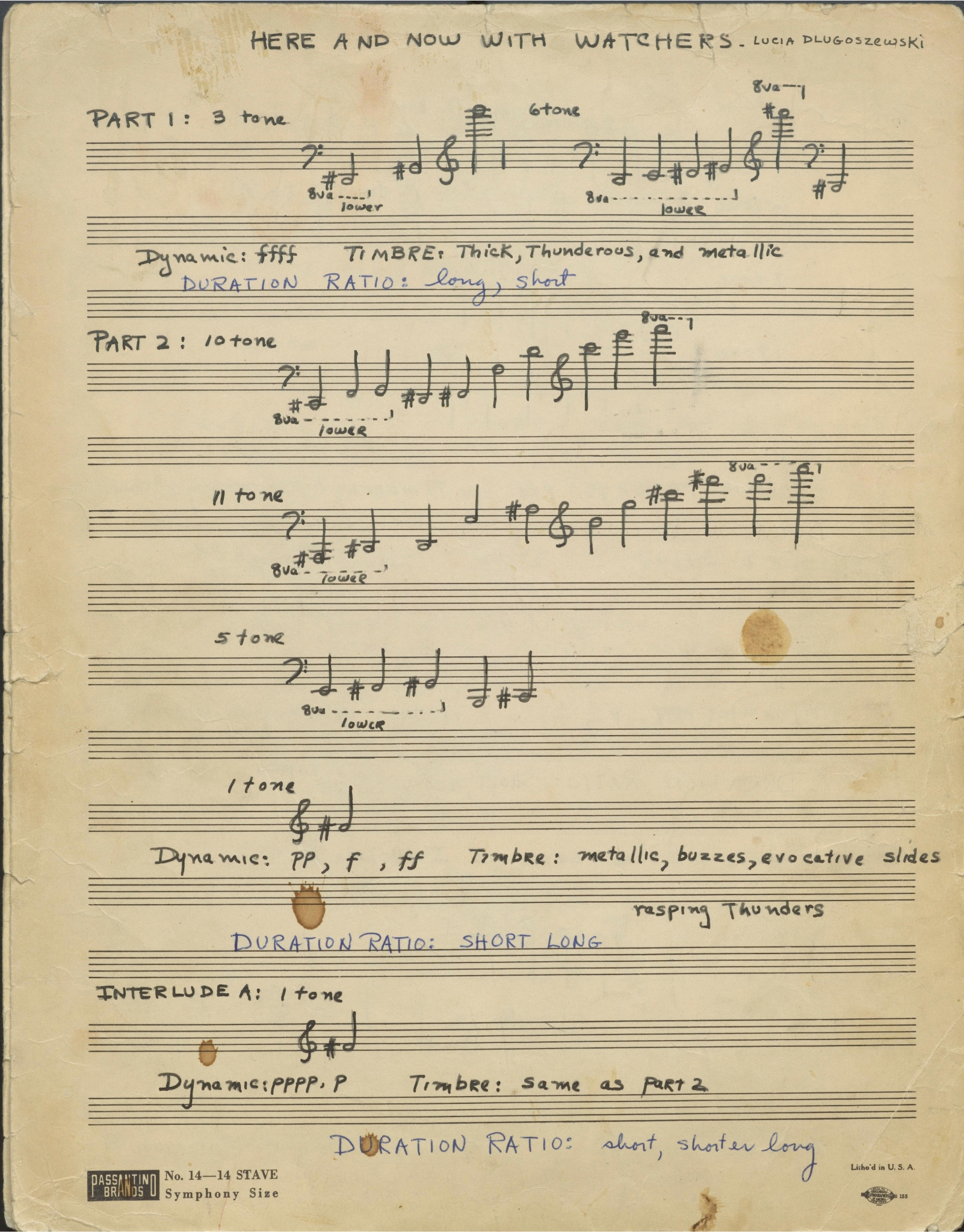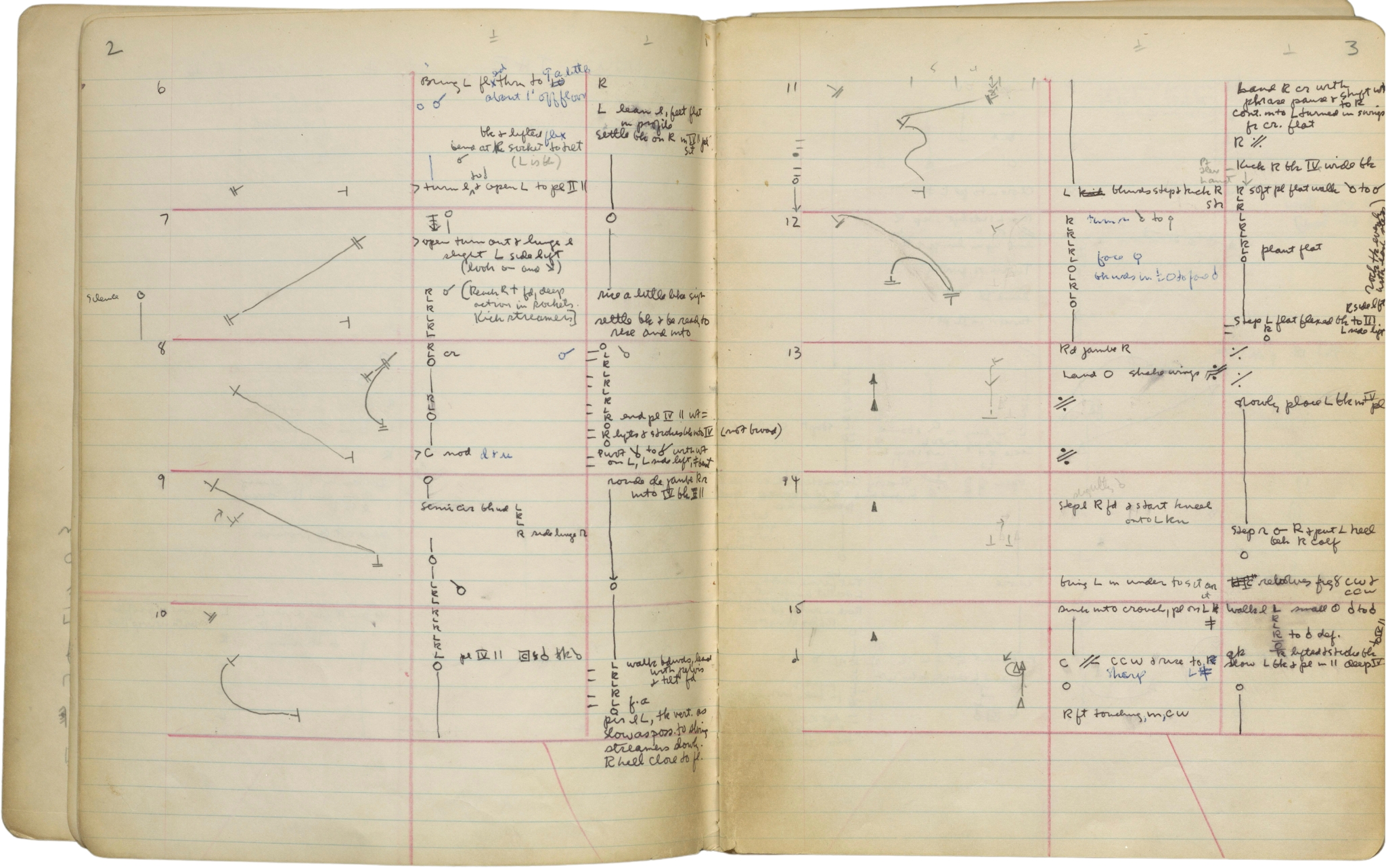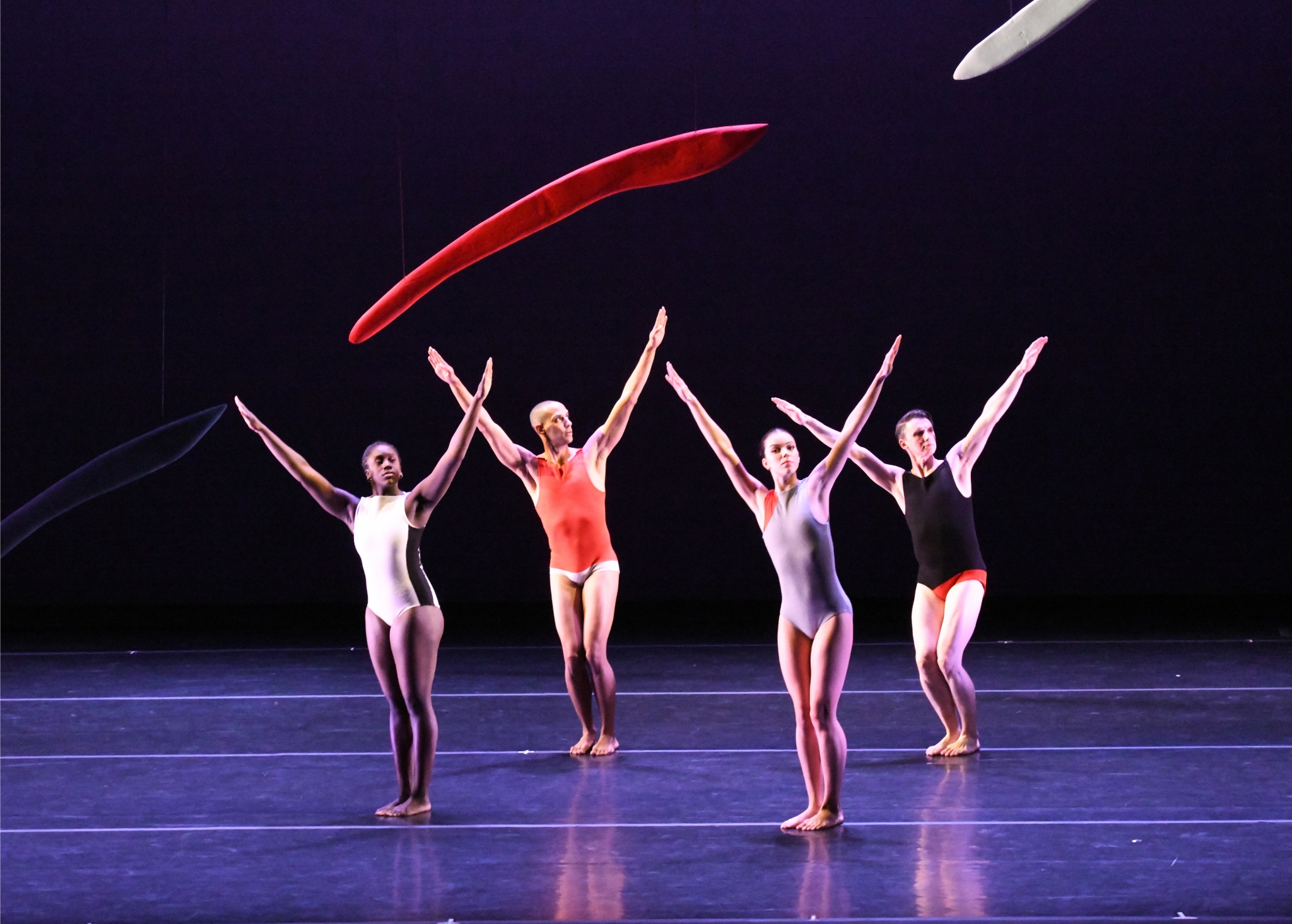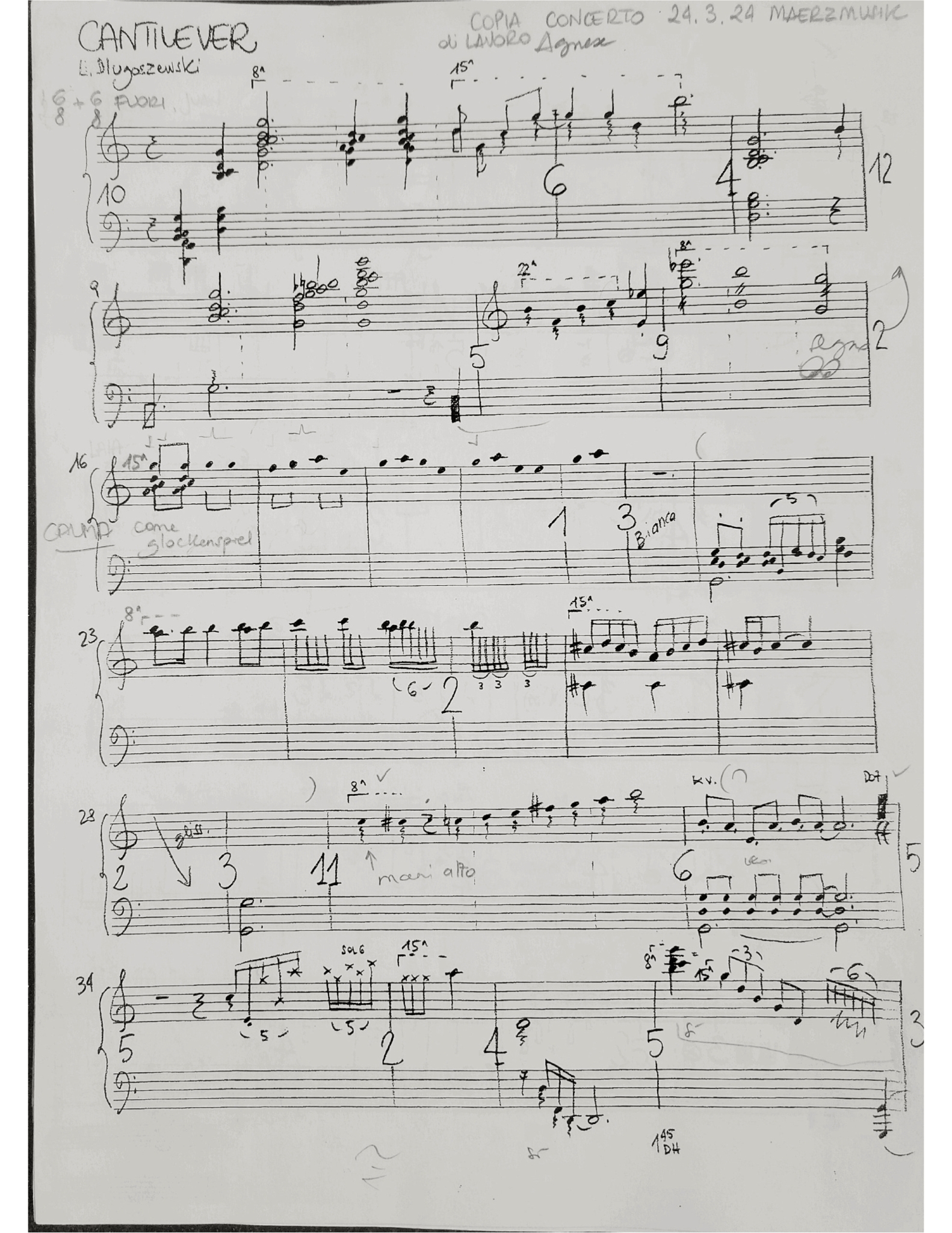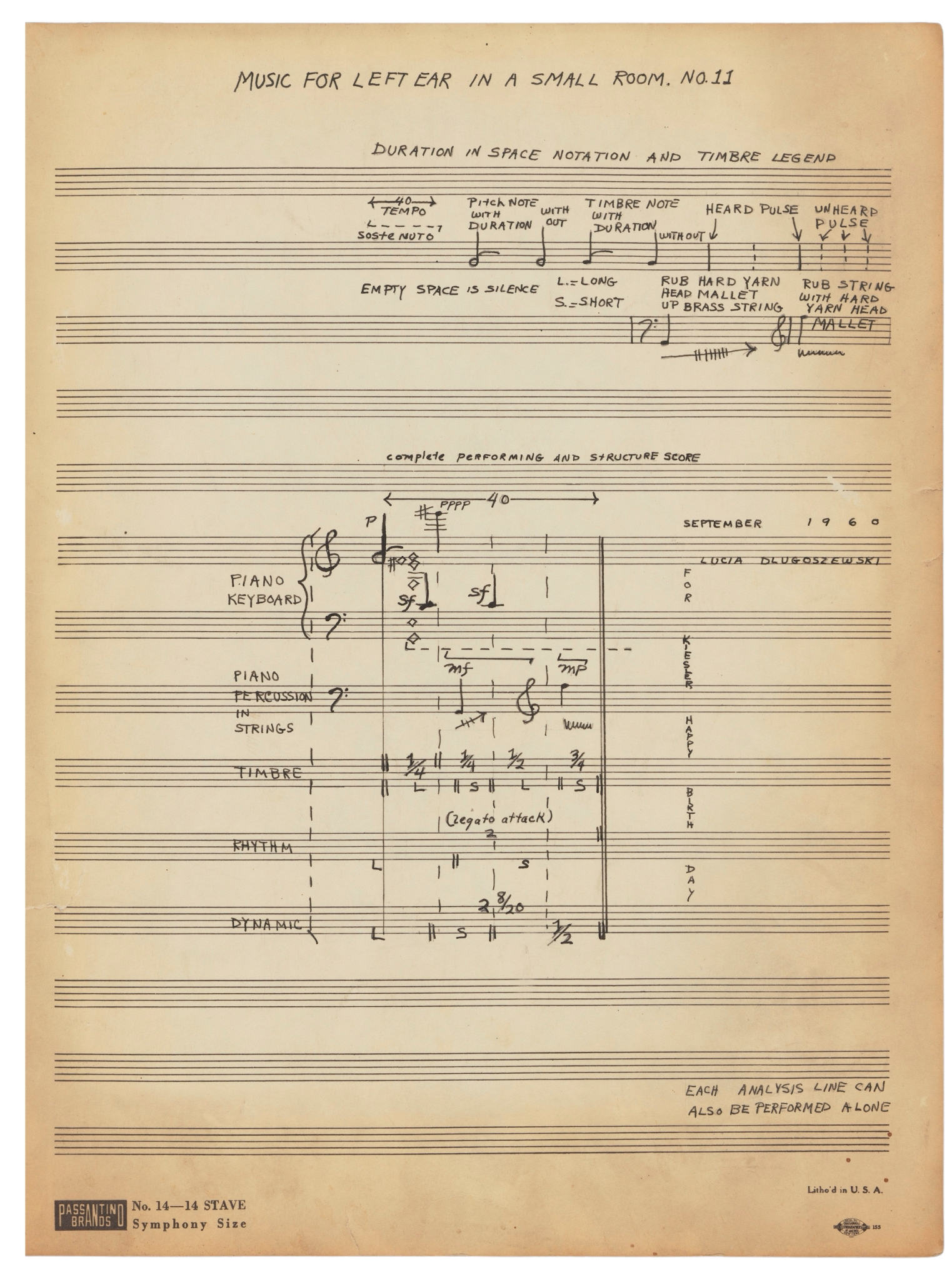LUCIA DLUGOSZEWSKI
Song for the Poetry of Everyday Sounds to the poem of e e cummings (1952)
For everyday objects, percussion, and voice; performed by:
– Rachel Beetz
– Dustin Donahue
– Andy Thierauf
LUCIA DLUGOSZEWSKI
Separated Music (1958)
a.) for rates of speed
b.) for delicate accidents
For ladder harps and wind bells; performed by:
– Dustin Donahue
– Michelle Purdy
– Andy Thierauf
LUCIA DLUGOSZEWSKI
MARIE MENKEN
Visual Variations on Noguchi (1945/1953)
Film by Marie Menken; score by Lucia Dlugoszewski (“The Poetry of Natural Sound”)
LUCIA DLUGOSZEWSKI
Excerpts from Openings of the (Eye) (1952)
II. Disconsolate Chimera
III. Ritual of the Descent
Performed by Network for New Music
– Susanna Loewy, flute
– Charlie Abramovic, piano
– Phillip O’Banion, percussion
LUCIA DLUGOSZEWSKI
Angels of the Inmost Heaven (1971)
For brass quintet, performed by:
– Chris Coletti, trumpet
– Peter Evans, trumpet
– Eric Reed, french horn
– Joe Fiedler, tenor trombone
– David Taylor, bass trombone
INTERMISSION
LUCIA DLUGOSZEWSKI
ERICK HAWKINS
Excerpts from Here and Now With Watchers (1957)
i) now: THE
viii) the (effortless) now: LIKE DARLING (shouts my body and shouts itself transparent)
For solo timbre piano and two dancers; Music by Dlugoszewski (reconstruction by Agnese Toniutti); choreography by Erick Hawkins.
Performed by the Erick Hawkins Dance Company
– Jason Hortin
– Hayley Meier
and
– Agnese Toniutti, timbre piano
LUCIA DLUGOSZEWSKI
ERICK HAWKINS
Cantilever (1963)
For solo piano with four dancers; Music by Dlugoszewski (reconstruction by Agnese Toniutti); choreography by Erick Hawkins.
Performed by the Erick Hawkins Dance Company
– Jason Hortin
– Hayley Meier
– JR Gooseberry
– Halie Landers
and
– Agnese Toniutti, piano
Lucia Dlugoszewski’s work from the 1950s offers a fascinating glimpse into a moment of radical transformation in American experimental music. Bridging the worlds of poetic abstraction, tactile sonic exploration, and instrument invention, her compositions from this period trace a clear arc—from her use of everyday materials as sound sources to the creation of a unique orchestra of handmade percussion instruments.
Among her earliest forays into this sound world is Song for the Poetry of Everyday Sounds to the poem of e. e. cummings (1952). The score calls for actions such as the tearing of paper (both slow and fast), the pouring of beans and rice, the bubbling of water through a straw, the wobbling of thin cardboard, the bouncing of balls, and the rolling of glasses in a fry pan. These are not treated as novelties but as integral sonic events, precisely notated and choreographed for their timbral variation and textural detail. The poem by cummings, “luminous tendril of celestial wish,” is specified in the score to be both written—by hand, during the performance—and spoken aloud at select moments, creating a layered interplay between language and sound. Rather than setting the text in a conventional manner, Dlugoszewski uses it as a structural and poetic thread that winds through the piece’s rich acoustic fabric.
This work is part of a broader constellation of compositions from the early 1950s in which Dlugoszewski pursued what she called “everyday sounds.” These include pieces like Everyday Sounds for [brIght], her setting of cummings’s “,!blac,” and a theatrical score titled Structure for the Poetry of Every Day Sounds (written for Alfred Jarry’s Ubu Roi), created for a production by The Living Theatre under the direction of Judith Malina. The Living Theatre, a pioneering force in avant-garde theater founded in 1947, was known for its politically engaged and experimental productions. Dlugoszewski also composed the soundtrack to Menken’s 1945 film Visual Variations on Noguchi in 1953, titling the music The Poetry of Natural Sound.
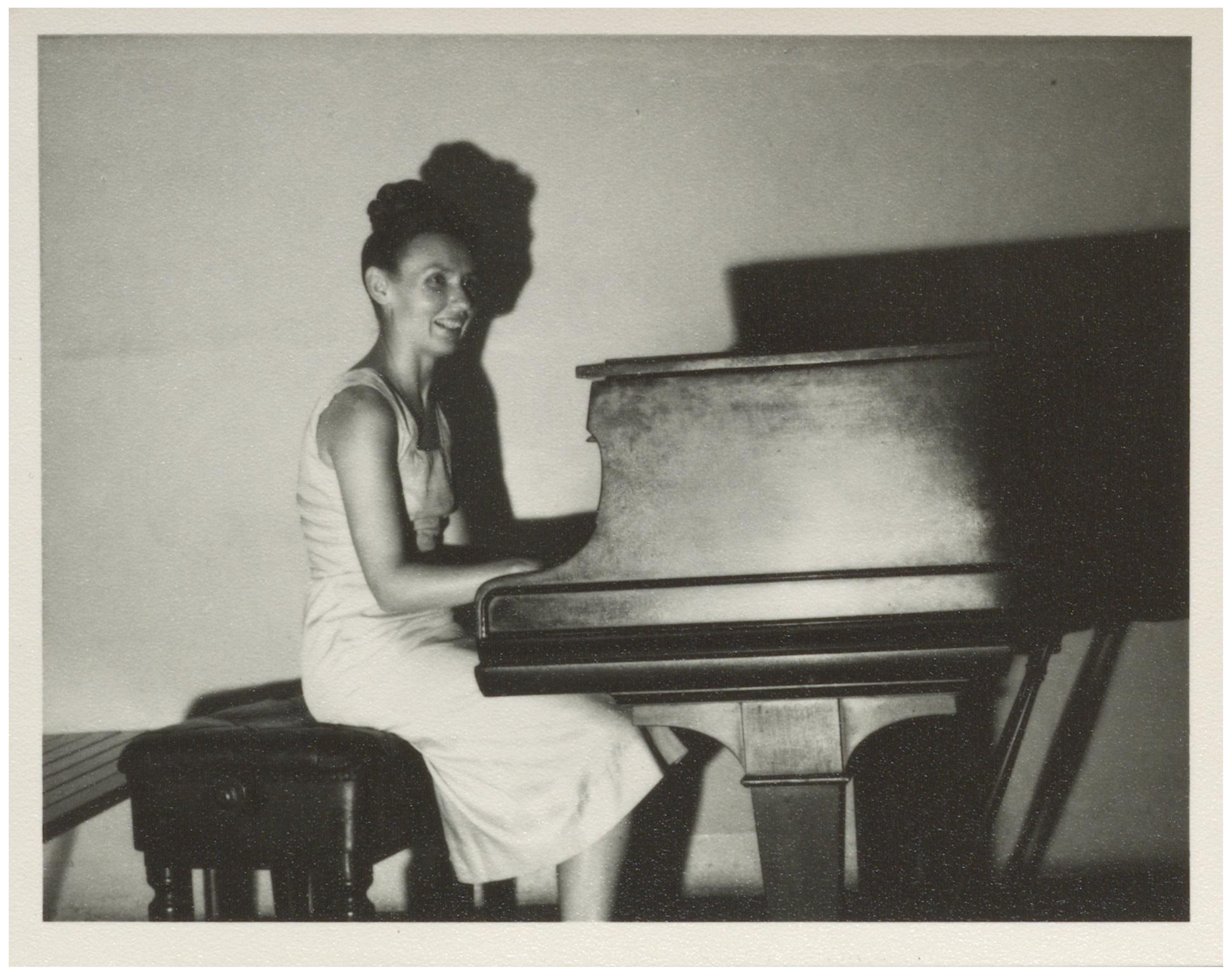
In the early 1950s, Dlugoszewski was an active participant in the New York School loft scene, closely connected with Cage and his circle. Though rarely acknowledged in parallel, her work from this period intersects strikingly with Cage’s, particularly in their shared exploration of nontraditional sound sources. Cage’s Water Music, composed in 1952, employs radios, whistles, and water to challenge conventional ideas of music-making. That same year, Dlugoszewski composed Song for the Poetry of Everyday Sounds to the poem of e. e. cummings, a piece that also turns to unconventional materials—but with a markedly different sensibility.
Her score is obsessively precise, concerned less with theatrical gesture or indeterminacy than with the intimate, textural details of sound. Rather than leaving sonic outcomes to chance, she shaped them through choreographed actions and specific instructions. It’s possible that her work may have influenced Cage’s own explorations, or at the very least, contributed to the vibrant cross-pollination of ideas within their shared artistic milieu. While Cage’s innovations are firmly ensconced in music history, Dlugoszewski’s contributions from this same period remain largely underrecognized—despite their comparable ambition and originality. Influence likely flowed in both directions.
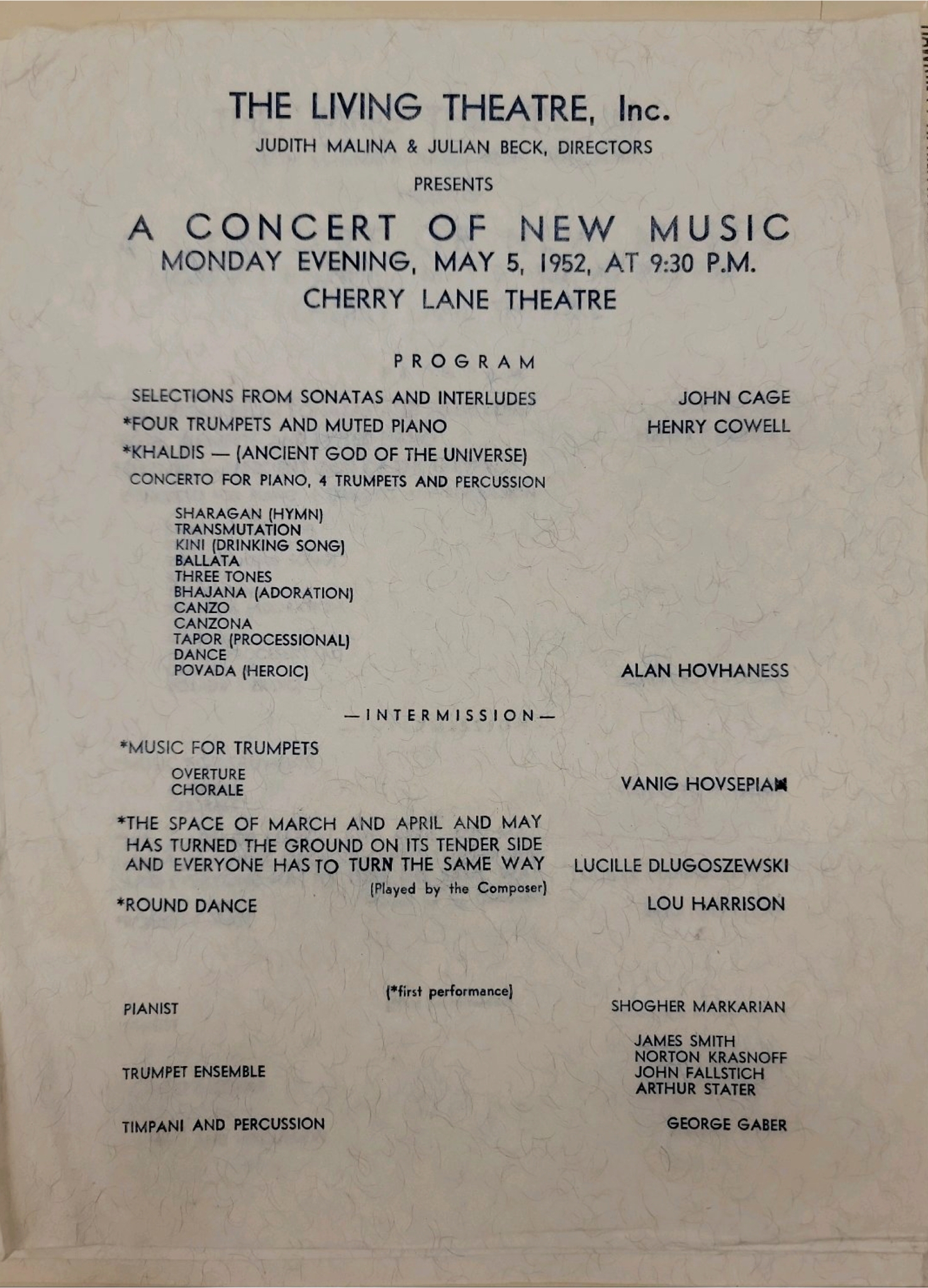

Her fascination with timbre eventually led her to design her own instruments. Around the same time she was developing her so-called “Timbre Piano”—a technique for playing directly on the strings and frame of a grand piano—Dlugoszewski began collaborating with sculptor Dorazio to construct new percussion instruments. This collaboration yielded a family of instruments that included ladder harps, wind bells, tangent rattles, and square drums. Rather than being one-off experiments, these instruments were conceived in large sets, with numerous subtle variations in timbre, pitch range, and dynamic capacity. Dlugoszewski approached their construction systematically, grouping them by material, playing method, and sound behavior to form extensive ensembles of related instruments. This allowed her to compose with intricate gradations of sound, creating a flexible and responsive musical language entirely of her own design.
Two early works for these invented instruments, both from 1958, are grouped under the title Separated Music. The first, for rates of speed, is composed for three pairs of ladder harps. Each ladder harp differs in dimensions and internal spacing, yielding subtle but significant shifts in timbre. The second, for delicate accidents, focuses on wind bells—long wooden dowels suspended in clusters and struck in various ways. Dlugoszewski’s scores for these works suggest not only new sounds but new modes of attention.
Separated Music can be seen as a set of studies leading toward her evening-length work 8 Clear Places (1960), composed as a major score for a Hawkins choreography, in which she deployed her full orchestra of 100 invented instruments. The music from this period embodies a sculptural sensibility, with form arising from gesture, texture, and change over time.
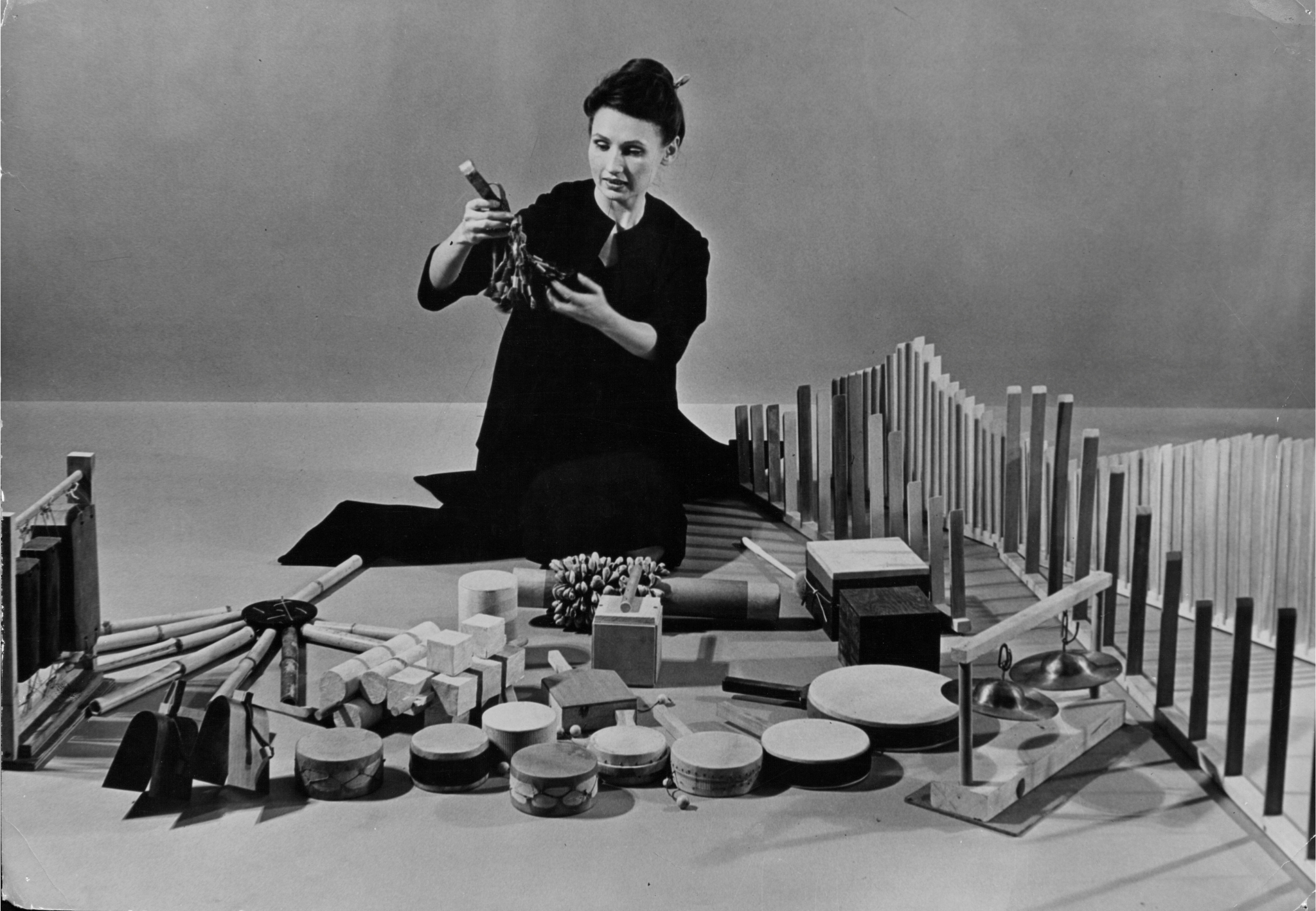
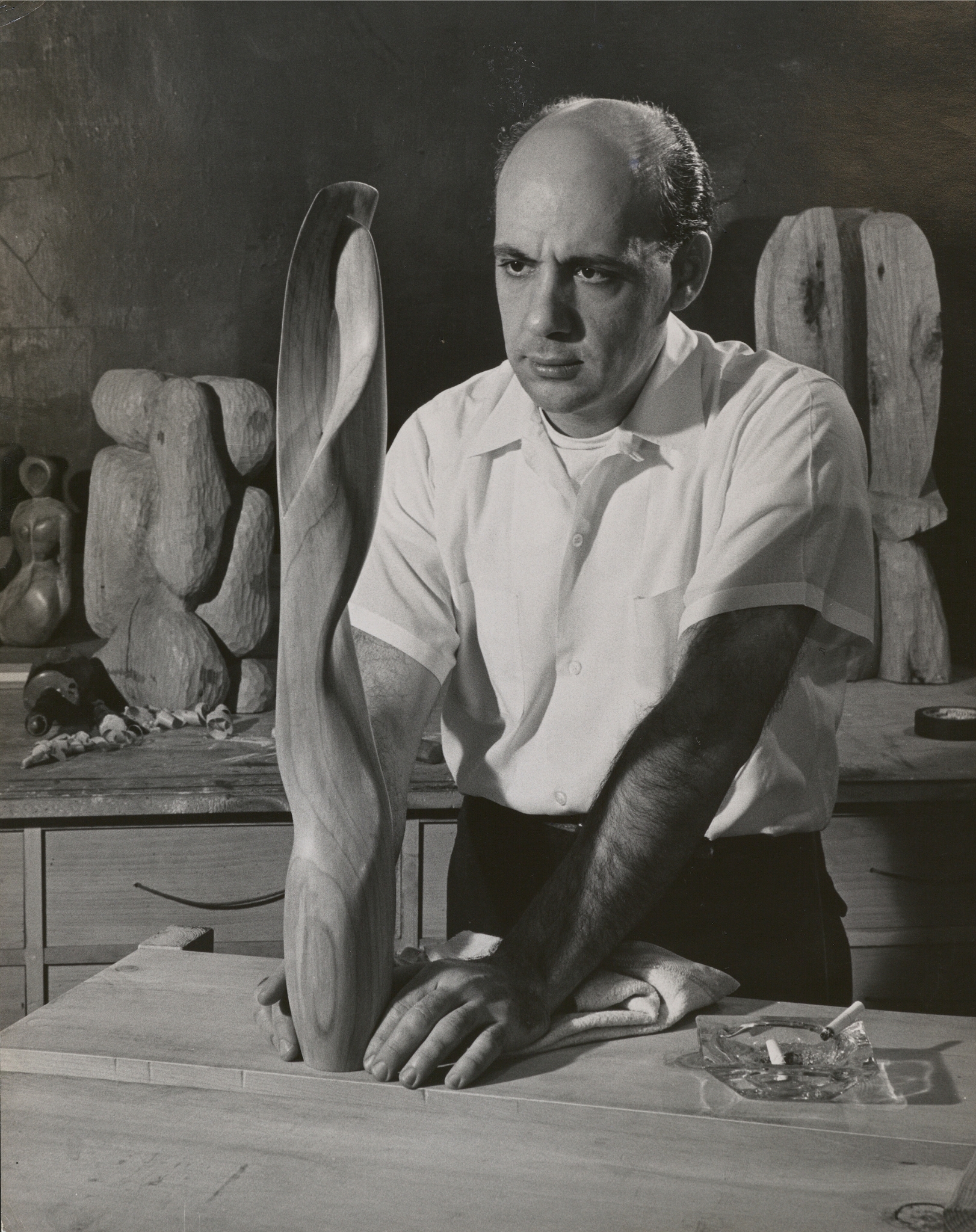
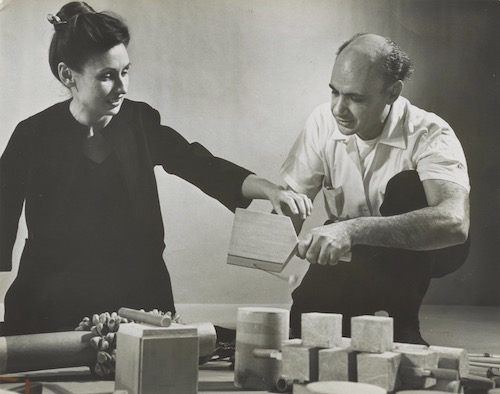

Visual Variations on Noguchi, the film by Menken, offers a complementary view of Dlugoszewski’s aesthetic. Shot in 1945 and scored in 1953, the short black-and-white film captures the play of light and shadow across Isamu Noguchi’s sculptures. Menken’s hand-held camera work, rapid and improvisational, echoes the tactile curiosity that Dlugoszewski brought to her sound world. The score itself, recorded on multitrack tape at the recording studio of Bebe and Louis Barron, stands as Dlugoszewski’s sole foray into musique concrète. Despite her general resistance to electronic music, the resulting piece is a dense, vivid sound collage—comparable in its ambition and method to Cage’s better-known Williams Mix, created at the same studio around the same time.
Though often overlooked in accounts of postwar American music, Dlugoszewski’s contributions during this era should be gaining renewed recognition. Her experiments with natural and everyday sound prefigure later developments in sound art, while her invented instruments and playing techniques remain singular. These works invite a heightened form of listening—one that values the ephemeral, the tactile, and the intricate play of difference.
Composed in 1952, Openings of the (Eye) marked the beginning of the long and influential collaboration between composer Dlugoszewski and choreographer Hawkins. Scored for flute, piano, and percussion, the evening-length work accompanied Hawkins’s dance of the same name, which drew on themes from Greek mythology and featured designs by artist Dorazio. Premiered in January 1952, the work toured widely across the United States and helped define the aesthetic of the Hawkins-Dlugoszewski partnership. In addition to its life as a dance score, Openings of the (Eye) was occasionally performed in concert, sometimes excerpted.
The piano writing in Openings of the (Eye) is notably virtuosic, offering a rare glimpse into Dlugoszewski’s exceptional skill as a performer—something often obscured in her later works for timbre piano. She performed the work herself, and archival rehearsal recordings suggest the piano may have been prepared in the Cagean sense, with materials inserted into the strings, though no definitive score instructions have been found to confirm this practice.
Like many of Dlugoszewski’s compositions, the piece exists in a layered and somewhat elusive form. Archival evidence suggests that an entirely different version of the score may once have existed, and early sketches reveal plans for a far more experimental and expansive percussion part than what appears in the final version. These unrealized threads point to the broader, restlessly inventive terrain Dlugoszewski was charting in the early 1950s, anticipating the radical sonic explorations that would characterize her later work.
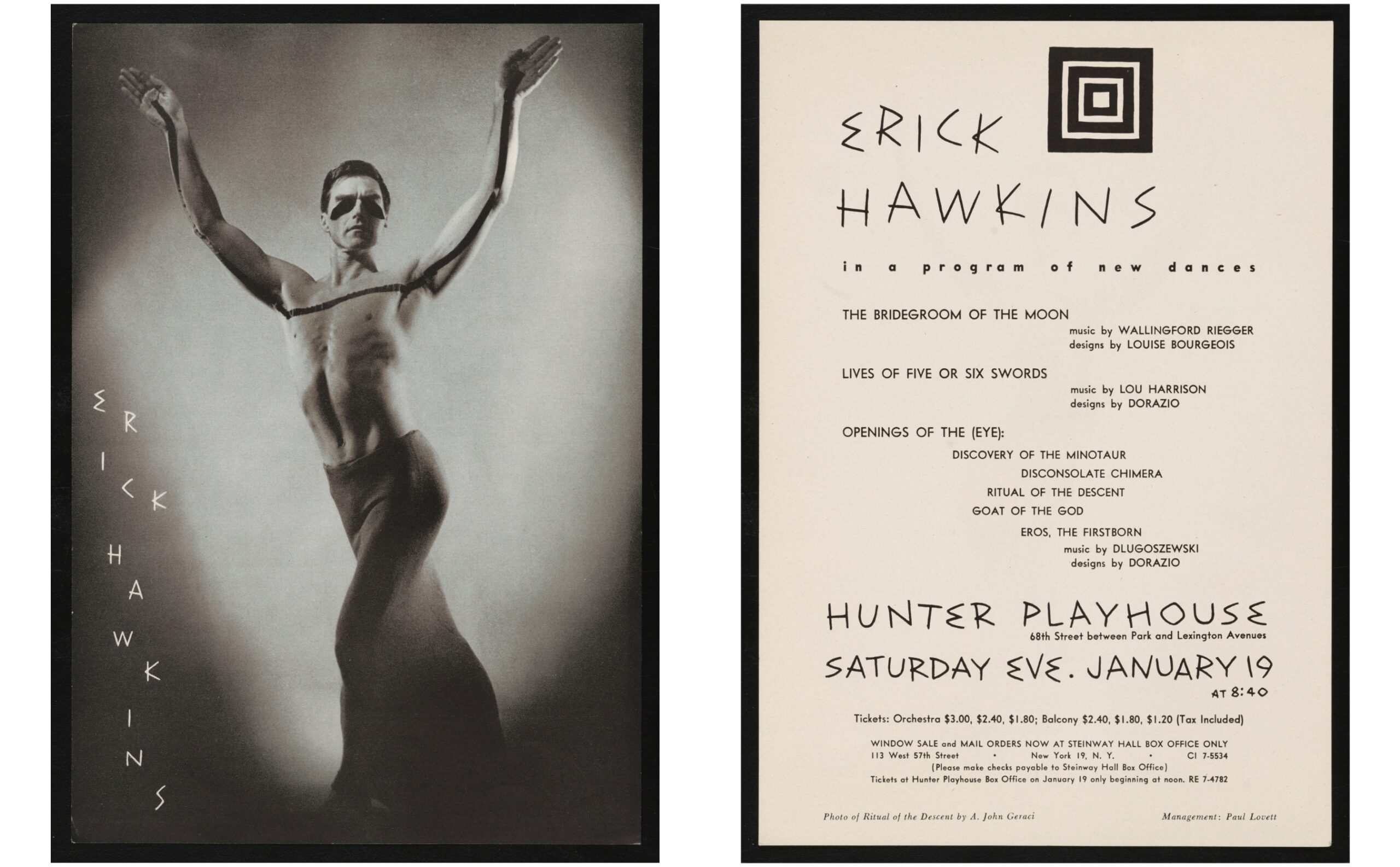
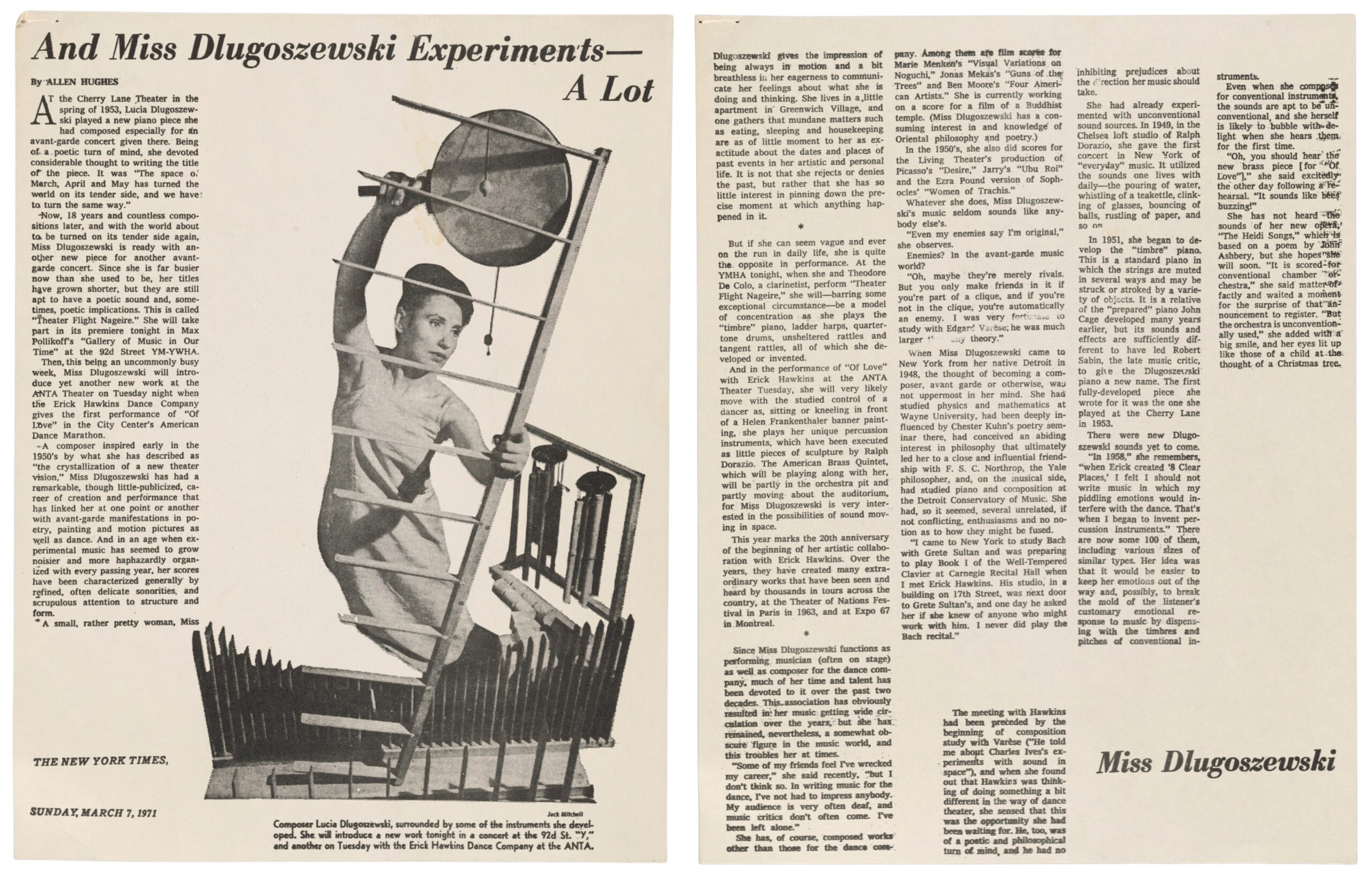
Angels of the Inmost Heaven marks the final major collaboration between composer Dlugoszewski and choreographer Hawkins for more than a decade. Premiered in 1971 in Washington, D.C., the piece appears in Dlugoszewski’s score under the alternate title Densities: Supernova/Corona/Clear Core. The work stands as a stunning exploration of new possibilities for brass quintet. Scored for two trumpets, French horn, tenor trombone, and bass trombone—eschewing the typical tuba—the piece exemplifies Dlugoszewski’s virtuosic imagination and her belief in music as an epiphany of sensation. Originally created in collaboration with Hawkins and choreographed for the stage, Angels of the Inmost Heaven is presented tonight without dance. It remains one of the few Dlugoszewski works to be both published and commercially recorded, with a 1975 release that has served as a vital reference point for performers and scholars alike.
Dlugoszewski’s score is a blueprint of extremes: she replaces traditional phrasing and barline logic with a modular structure—eight continuous segments of 55 seconds each, subtly “curved” and “stretched”—designed to accommodate what she called “epiphanies of density.” While the written notation is largely conventional, the score calls for a vivid and highly original palette of extended techniques—including partial-valve glissandos, quarter-tone trills articulated through precise mute manipulations, and dynamic permutations that stretch the expressive range of each instrument. Many of these techniques build directly on ideas first explored in Dlugoszewski’s 1970 solo trumpet work Space is a Diamond. Throughout, phrases move between three distinct states: the volatile bursts of Nova, the sudden decays of Corona, and the intense, nearly static density of Clear Core. The result is a choreography of sound—fluid, forceful, and richly textural.
The title Angels of the Inmost Heaven references a passage from the 18th-century mystic Emanuel Swedenborg, who described a celestial realm where “the angels of the inmost heaven are not clothed.” In Swedenborg’s cosmology, this highest heaven—closest to the divine—is defined by purity, innocence, and a union of good and truth. Dlugoszewski’s music, with its rarefied textures and sculpted densities, offers a kind of sonic analogue: a domain where structure becomes transparent, and sound itself takes on a form of radiant immediacy.
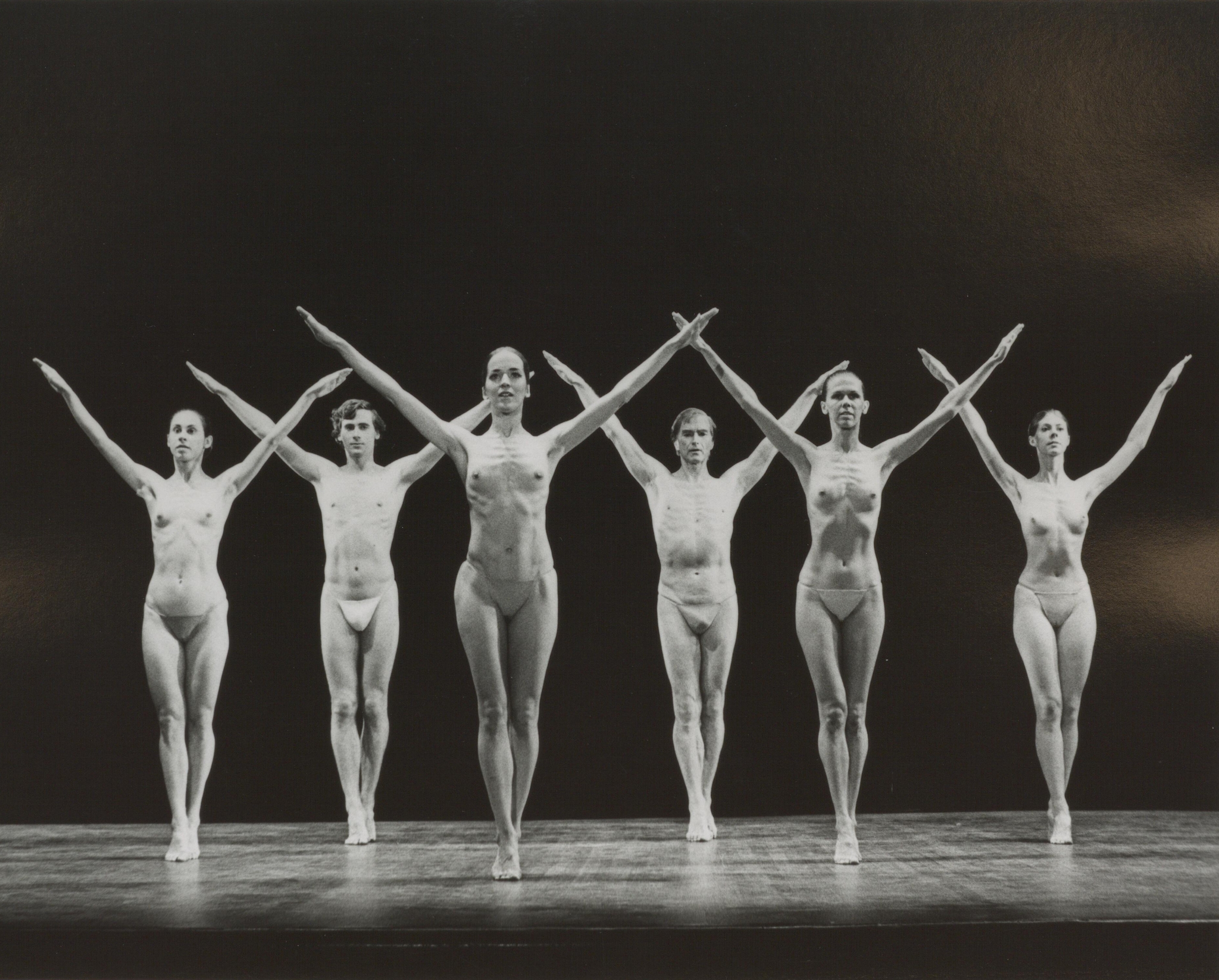
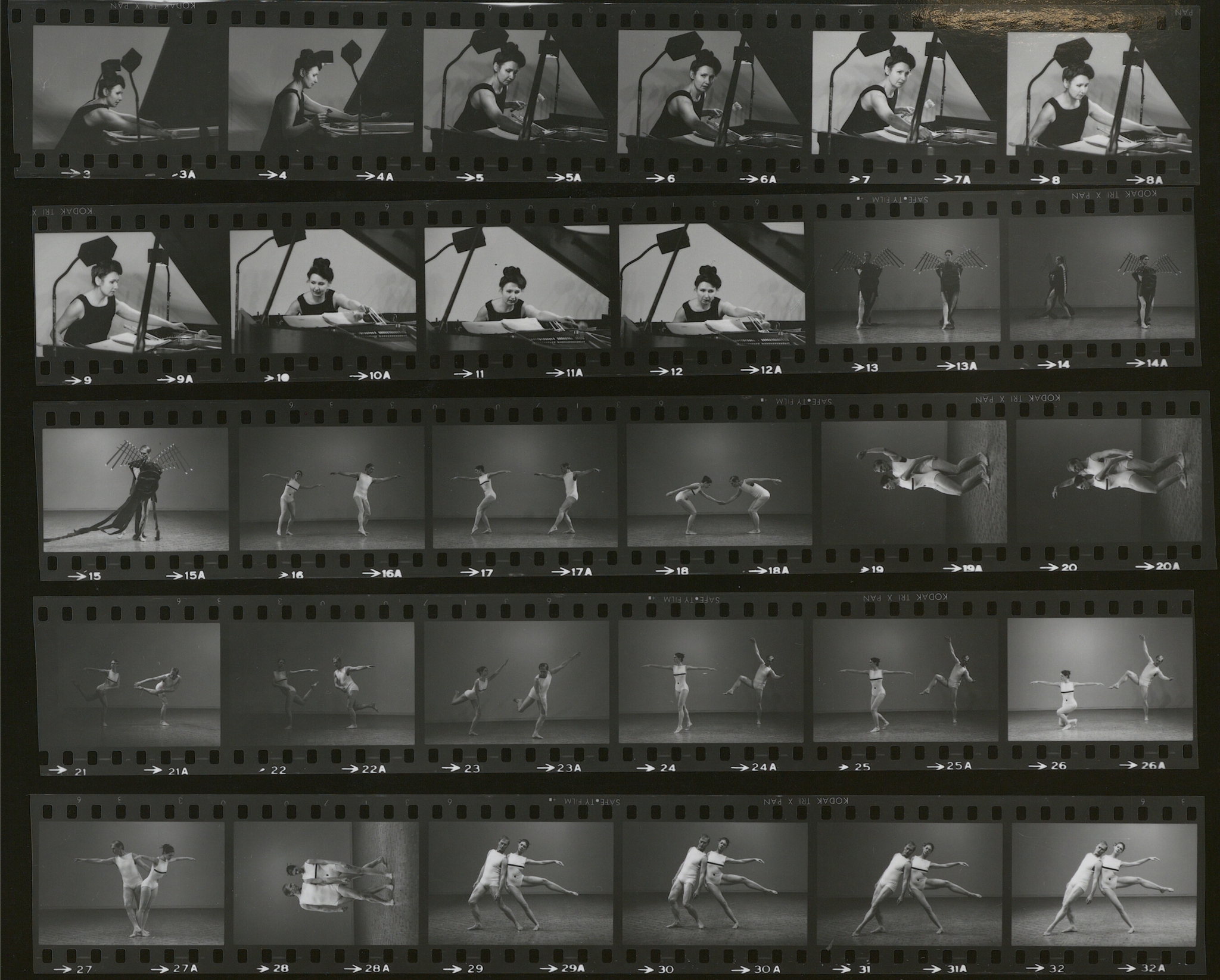
Here and Now with Watchers (1957) was the second collaboration between composer Dlugoszewski and choreographer Hawkins, following Openings of the (Eye) (1952). Dlugoszewski began composing the music in 1954; it was first performed in-progress in 1955 and premiered in full in 1957. The choreography was created and performed by Hawkins alongside dancer Nancy Lang, with early development involving Eva Raining. The work toured extensively across the United States and became a signature piece of the Hawkins/Dlugoszewski partnership. Within the music community, it was regarded by many as a major work. Dlugoszewski titled the score Archaic Timbre Piano Music, though the name was rarely used in performance materials.
The music is composed for solo timbre piano—a term suggested by music critic Robert Sabin and adopted by Dlugoszewski to describe her performance practice on the grand piano. The technique employs a system of moving plectrums, resonators, and mutes placed inside the piano strings. In a handwritten note, she wrote that this approach was intended “to access an entirely new area of sound—one that is both self-perpetuating and expands the range of percussive timbre.”
According to a program note by Dlugoszewski, the music was composed after the choreography and was structured to remain moment-by-moment aware of the dance’s durations while maintaining its own temporal identity. The score is built from ten distinct layers, each representing one sonic aspect: pitch, dynamics, durations, or timbre. Within these layers, musical material is “bracketed”—introduced at specific points and never repeated.
Pitch materials are organized into non-repeating collections ranging from one to twelve tones, selected for their qualitative properties. These groupings, such as 3, 10, 5, and 11, avoid conventional harmonic or serial structures. Rhythmic form is shaped through “heard pulse” patterns like short-short-long, long-short, and long-long-short-short, which function outside traditional motivic development. Dynamic contrasts are used structurally across the layers.
Silence is treated as an active compositional element, defined in three types: small silence, large silence, and no silence. It is the only material that moves freely between the layers. A conceptual chart sometimes included in programs, titled the “Curtain of Timbre,” reflects this framework. Though not a performance score, the chart illustrates Dlugoszewski’s compositional priorities and structural thinking.
The choreography for Here and Now with Watchers departs from psychological or narrative content, instead focusing on movement as sensation and presence. In a 1970s review of a revival performance, critic Anna Kisselgoff noted Hawkins’s rejection of the “psychology-through-movement” approach dominant in modern dance. Instead of seeking meaning in gesture, his work asked audiences to attend to what the movement makes one feel. The result, she wrote, was a kind of clarity and sensuousness that challenged American dance norms, drawing more readily from the aesthetics of Asian performance traditions. The piece, composed of solos and duets, was described as uncluttered and effortful in its calm, with dancers moving through gliding steps and “melting leaps.”
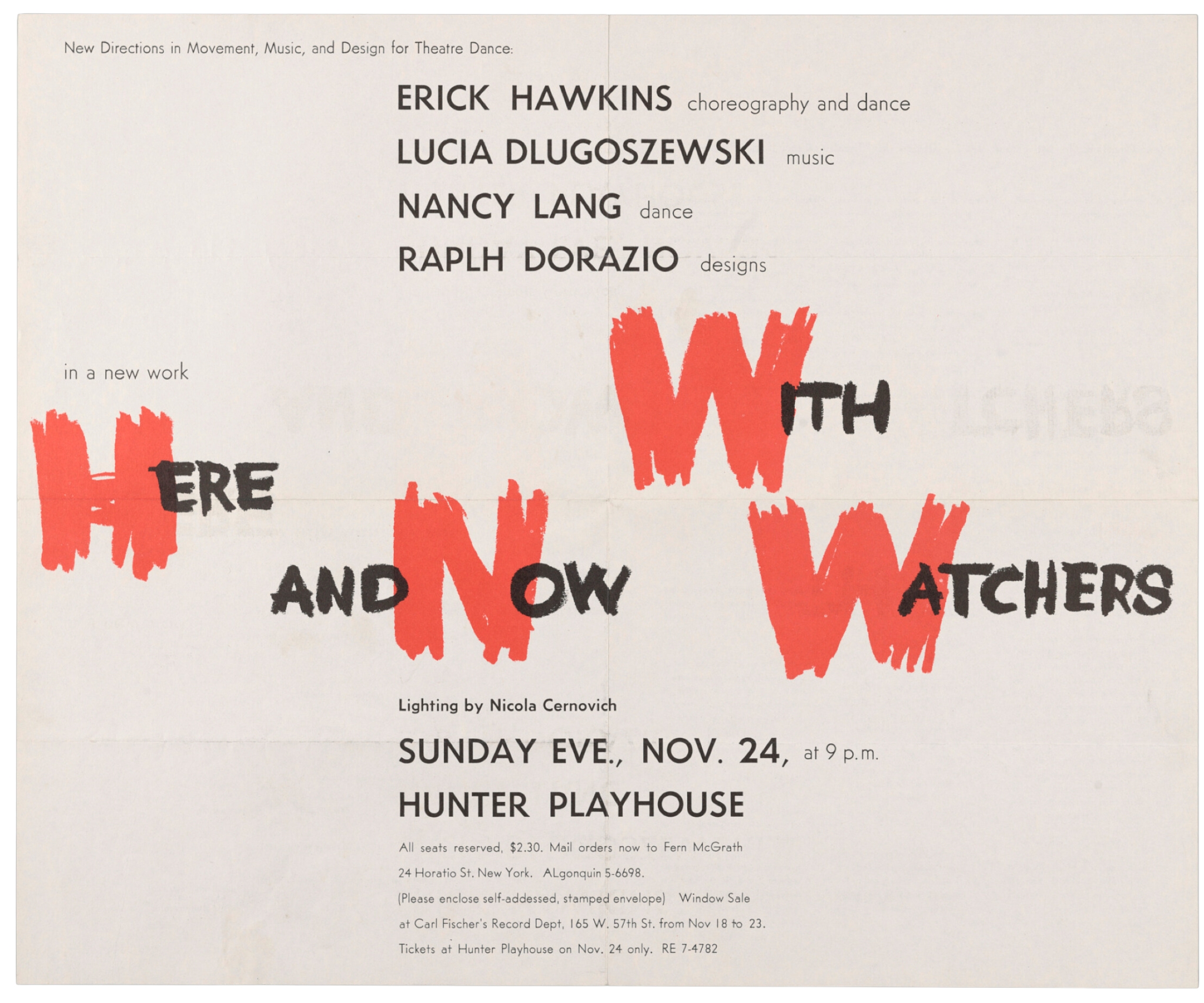
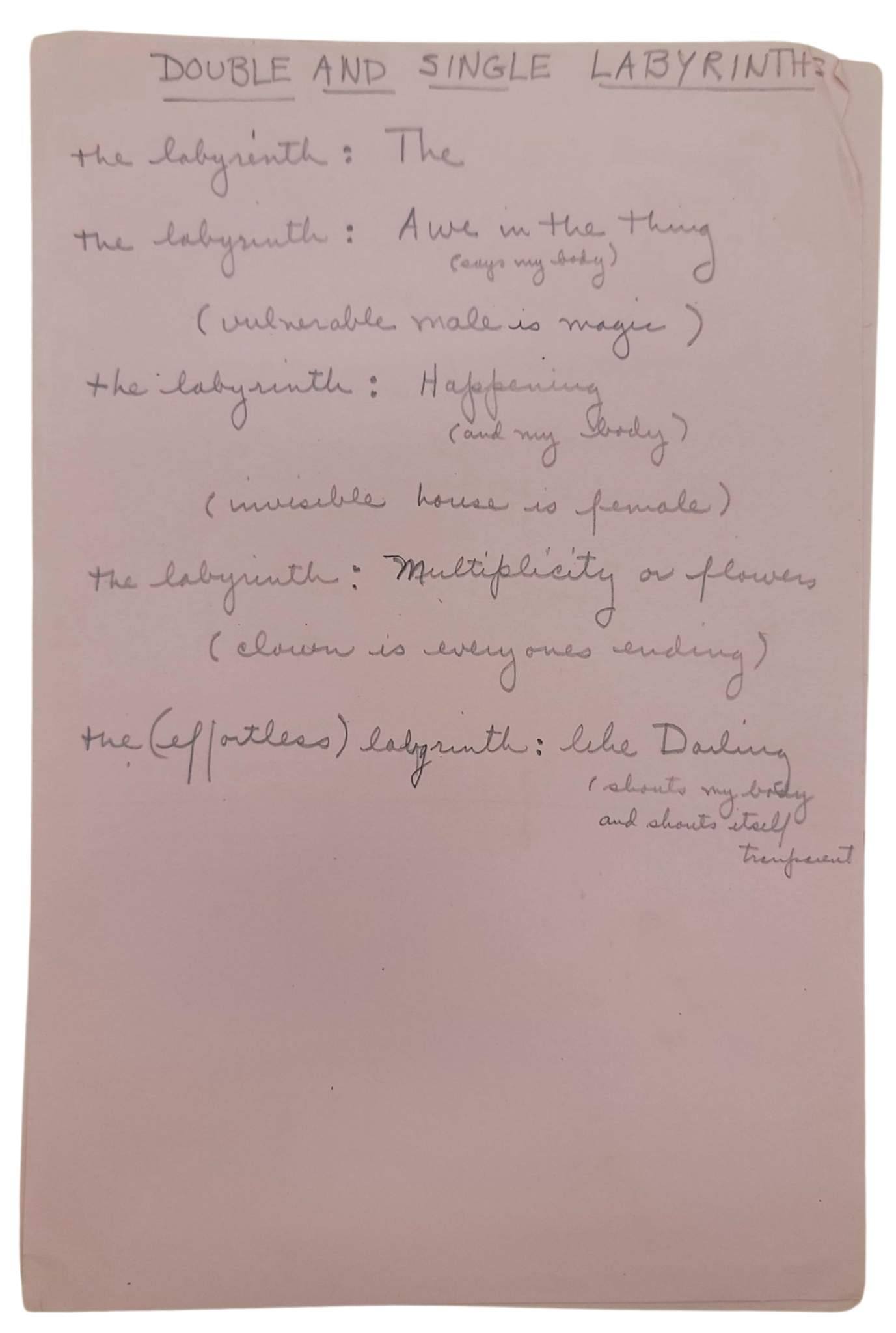
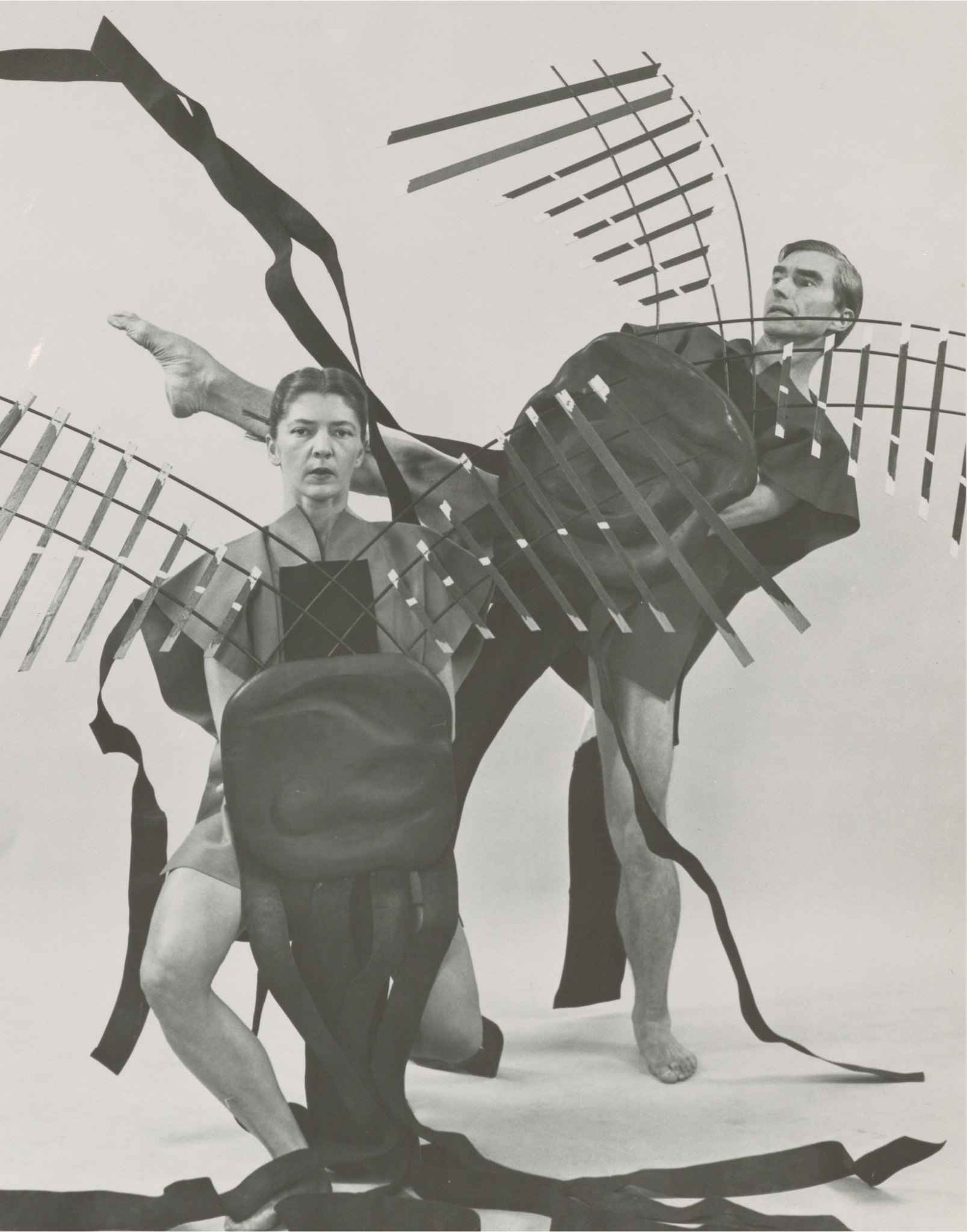
Cantilever premiered in Paris in June 1963 at the Théâtre Récamier during the Théâtre des Nations Festival. Created by Dlugoszewski and Hawkins for four dancers and solo piano, the work became a central part of the Hawkins Dance Company’s touring repertory and was performed widely across the United States throughout the 1960s and 70s. In 1988, Dlugoszewski expanded the score and Hawkins restructured the choreography into a new version titled Cantilever II, for twelve dancers and chamber ensemble. The work is dedicated to Austrian-American architect Frederick Kiesler and was originally presented with a suspended sculptural set by Dorazio.
Dlugoszewski wrote the piano part for herself, departing from the extended techniques that became a hallmark of her later “timbre piano” works. Instead, she composed a part that engages primarily with the keyboard, using dense chord clusters, percussive attacks, and abrupt dynamic shifts. These techniques—while inventive—rely on more conventional approaches to the instrument and give Cantilever a distinct place within her catalog. She described the score as an attempt to harness the drive and momentum of baroque music without referencing its melodic or structural forms.
No finalized score exists for the original piano version. Dlugoszewski performed from a combination of shorthand sketches and working notes, which allowed for flexibility in live performance. In the following decade, she developed several expanded versions for ensemble, introducing winds, strings, and percussion. In these versions, the role of the piano shifted: it became more textural and reintroduced aspects of her timbre piano style, while other instruments absorbed much of the material that the solo piano had previously carried.
Hawkins described the dance as inspired by the experience of rising through a skyscraper and suddenly seeing far into the distance. He conceived it as a tribute to American architects and the growing urban landscapes they shaped. Choreographed for two men and two women, the piece reflects Hawkins’s distinctive movement language—fluid, breath-based, and stripped of ornament. The dancers move independently of the music, encountering it as a parallel force rather than responding to it directly. The choreography avoids overt gesture and instead emphasizes sculptural clarity, with a focus on spacing, groupings, and rhythmic flow. While the instrumentation evolved, the dance’s structure remained closely aligned with the musical durations, and the original choreography provided the basis for Cantilever II, which expanded the scale while retaining the same underlying ideas.
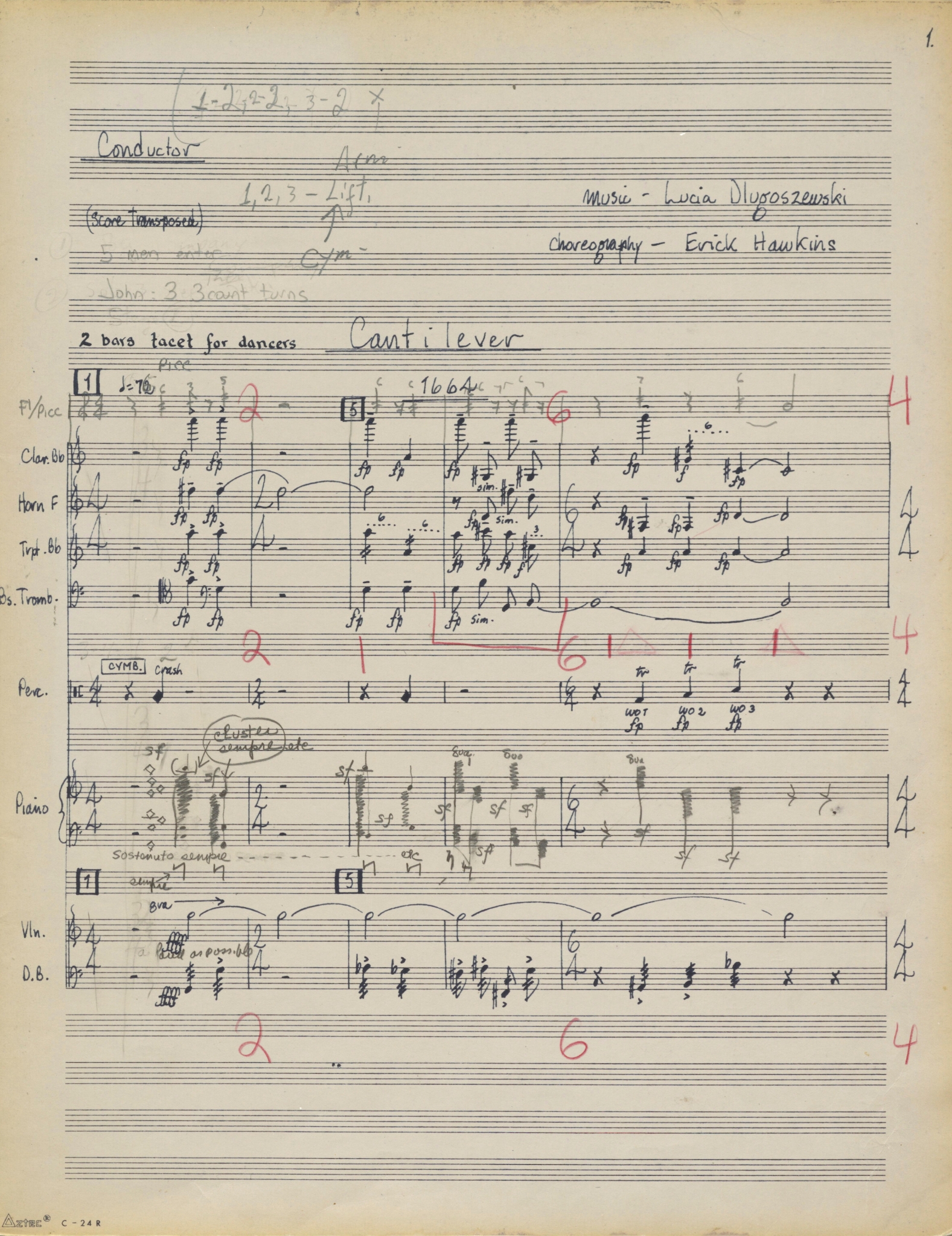
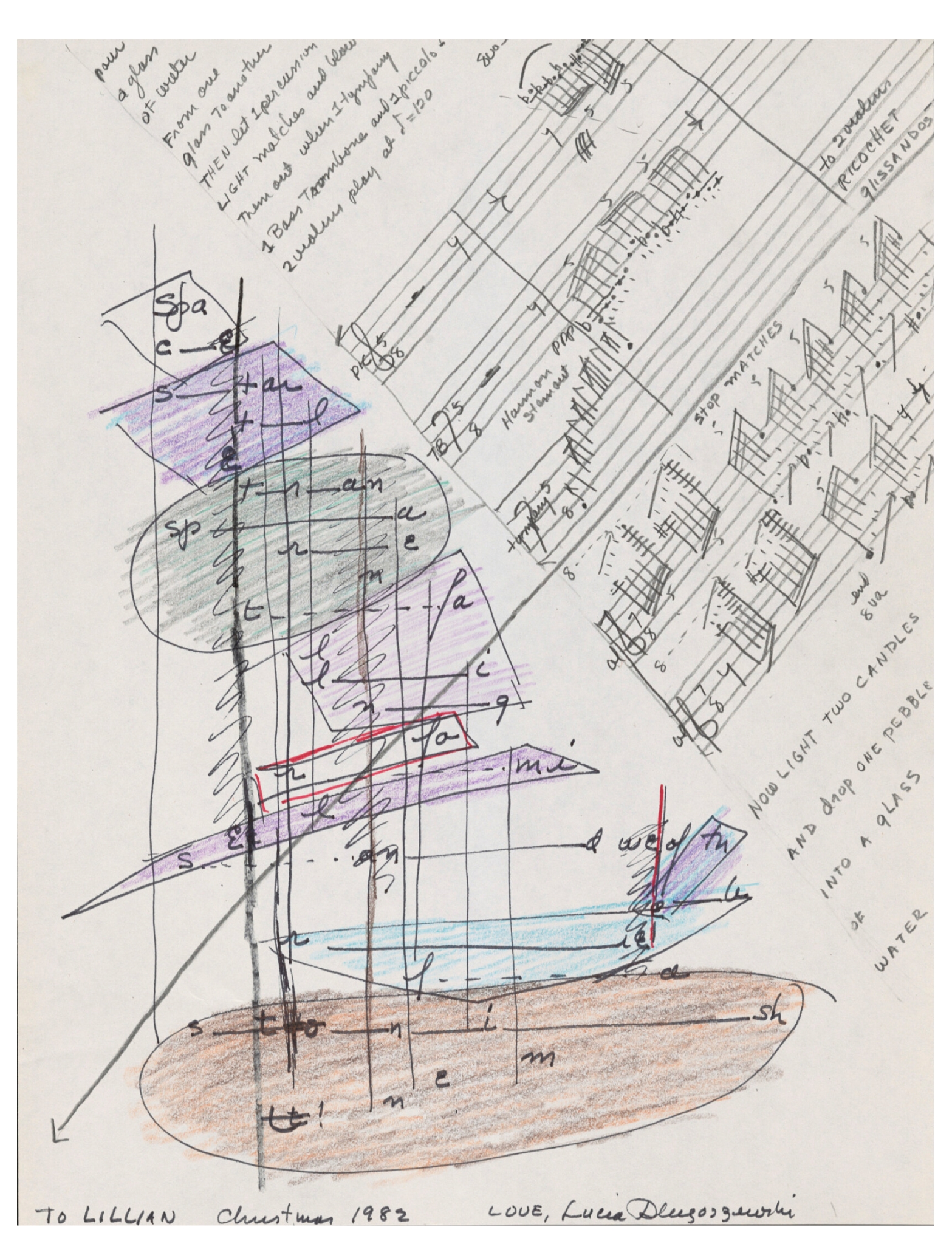
ABOUT THE ARTISTS
Lucia Dlugoszewski (1925–2000) was an American composer, poet, and performer whose work challenged the conventions of postwar music. Born in Detroit to Polish immigrant parents, she moved to New York in 1949, where she studied with Edgard Varèse and became immersed in the city’s experimental arts scene. She developed a radical performance practice called the “timbre piano,” which used mallets and objects to activate the strings and frame of the instrument, and she built an ensemble of invented percussion instruments in collaboration with sculptor Ralph Dorazio. For nearly fifty years, she was composer-in-residence for the Erick Hawkins Dance Company, creating over twenty scores in close dialogue with choreography. Her concert works—commissioned by the New York Philharmonic, Library of Congress, and others—expanded the expressive possibilities of acoustic instruments and often centered timbre and gesture over melody or harmony. Long overlooked, her legacy is now being rediscovered as a vital voice in 20th-century experimental music.
Erick Hawkins (1909–1994) was born in Trinidad, Colorado. He graduated in 1932 from Harvard University. German dancer Harald Kreutzberg so impressed him that he went to study with him in Austria. Then he studied with George Balanchine at the School of American Ballet. In 1937 he choreographed Show Piece which was performed by Ballet Caravan. Hawkins was the first man to dance with Martha Graham performing the male lead in a number of her works, including Appalachian Spring in 1944. Not long afterwards, he met and began collaborating with the experimental composer Lucia Dlugoszewski. Together they moved towards an aesthetic vision detached from realistic psychology, plot, social or political agenda and redefining dance technique according to newly understood principles of kinesiology, creating a bridge to later somatic studies. On October 14, 1994, one month before he died, he was presented with the National Medal of Arts by President Clinton.
As a composer and sound artist, Rachel Beetz considers sound as touch and is particularly influenced by natural and mechanical environments, the life of objects, interpersonal collaboration, and deep listening. Combining experimental field recordings and electronically modified flutes, her works examine community, environmentalism, and women’s work through sound, textiles, and lighting. Beetz’s sound projects have taken her from a sunless winter fjord to the mountains of Southern California, and to empty grain bins of the American Midwest. She held residencies in art houses in rural Iceland, the Women’s Center for Creative Work in Santa Fe, New Mexico, the Los Feliz Charter School for the Arts in Los Angeles, the Atlantic Center for the Arts in Florida, and the Walden Creative Musicians retreat. Her projects have been featured in concert halls and galleries in Australia, Iceland, India, the United Kingdom, and the United States. You can find her compositions and electronic music on Orenda and Populist records in addition to her independent artist bandcamp website.
Dustin Donahue is a percussionist dedicated to contemporary chamber music. He performs with the Partch Ensemble, Wasteland, and ECHOI, and appears with frequently the International Contemporary Ensemble. He has performed for many of North America’s top presenters of chamber music, such as the Los Angeles Philharmonic’s Green Umbrella series, Lincoln Center’s Mostly Mozart Festival, the Ojai Music Festival, the Festival Internacional Cervantino, and the Park Avenue Armory. An advocate for contemporary music, he frequently collaborates with living composers, such as recent projects with Carolyn Chen, Ash Fure, Laure Hiendl, Bruno Ruviaro, Steven Takasugi, and Yiheng Yvonne Wu. He is currently Assistant Professor of Percussion at the University of Maryland, Baltimore County.
Andy Thierauf is a Philadelphia-based percussionist specializing in contemporary music with a focus on integrating percussion with theater, dance, and technology. He often performs with the Arcana New Music Ensemble, NakedEye Ensemble, Unseen Rain, among others as well as collaborating with choreographers and dance companies like Vervet Dance, the Naked Stark, and Anne Marie Mulgrew and Dancers Company. Andy teaches at Settlement Music School and is an adjunct professor at Kutztown University.
Michelle Purdyis a contemporary percussionist and teaching artist currently residing in Butler, Maryland. Her sonic explorations tend to favor the mingling of found objects with more traditional instruments and an affinity for chance and improvisation whenever possible. Purdy also has been studying Javanese & Balinese Gamelan under the tutelage of Prof Gina Beck and is a board member for The High Zero Foundation and 2640 Collective. Ms. Purdy teaches at Carroll Community College, Towson University & UMBC. She has performed locally in Baltimore’s High Zero & Artscape Festivals and abroad at So Percussion’s Summer Institute, IFCP at Mannes, June in Buffalo, Make Music New York, and The Center for Advanced Musical Studies at Chosen Vale. She received her B.A. in Percussion Performance at UMBC and her Master’s degree from SUNY Buffalo.
Marie Menken (1909–1970) was an influential American experimental filmmaker known for her lyrical, kinetic style and pioneering use of handheld camerawork. A central figure in New York’s avant-garde film scene, she created visually dynamic works such as Visual Variations on Noguchi (1945/52), Glimpse of the Garden (1957), and Notebook (1962). Menken was a mentor and inspiration to artists like Andy Warhol and Stan Brakhage, and her films continue to resonate for their immediacy, playfulness, and poetic intensity.
Network for New Music commissions and performs new musical works by emerging and established artists of all identities, engaging audiences with vibrant and thought-provoking experiences. We prioritize excellent performances, innovative curation, in-depth education programs, and cross-genre collaborations, enriching Philadelphia’s cultural life. The Network Ensemble, a flexible 20-member group whose musicians also perform with leading local ensembles like the Philadelphia Orchestra and Opera Philadelphia, presents meticulously rehearsed performances of music by composers from the United States and abroad. Since 1984, the Ensemble has presented over 650 works and recorded four CDs for Albany and Innova labels. Committed to education, the Network Ensemble has collaborated with students from institutions including Curtis Institute of Music, University of Pennsylvania, Temple University, and Swarthmore College. The Ensemble has maintained a residency at Haverford College since 2007, fostering emerging talent and deepening engagement with contemporary music.
Chris Coletti is a trumpeter, soloist, chamber musician, arranger, conductor, and educator with a career spanning some of the most prestigious stages and ensembles in the world. He regularly performs as a soloist with orchestras and appears in recital and chamber settings, performing on both modern and baroque trumpet. He is Principal Trumpet of ROCO-Houston and the Huntsville Symphony Orchestra, and frequently performs and records as guest principal with the Saint Louis Symphony Orchestra and others. Drawn to bold, imaginative repertoire that spans styles and eras, Coletti has premiered countless works as a soloist, orchestral and chamber musician, and as music director of Ithaca College’s Contemporary Ensemble. He has performed with a wide range of artists across genres, spanning Pierre Boulez, Jon Batiste, Kanye West, Gloria Estefan, Kurt Masur, and Riccardo Muti. A former member of the Canadian Brass, he toured internationally for over a decade and appears on more than a dozen of the ensemble’s acclaimed recordings. He is Assistant Professor of Trumpet at Ithaca College.
Peter Evans (b. 1981) is a visionary trumpeter, composer, and bandleader. Known for his fearless blend of genres and sounds, he leads several different projects, most notably the quartet Being & Becoming (with Joel Ross, Nick Joz and Tyshawn Sorey). Working in formats ranging from solo trumpet to large ensembles, Evans’ engagement with the creative process moves beyond traditional distinctions of style. A prolific recording artist, he has released 20 recordings under his name, mostly through his own label More is More Records. Evans has worked with a wide range of artists such as John Zorn, Ellliott Carter, Evan Parker, Craig Taborn and many more. A 2022 Guggenheim Fellow in Music Composition and the recipient of other major commissions from institutions such as the Donaueschingen Musiktage and Venice Biennale, Evans tours internationally and has been based in New York City since 2003.
Trombonist/composer Joe Fiedler is known to critics as “among the most impressive trombonists to emerge in the past couple of decades.” (Harvey Pekar, Signal to Noise) Based in New York since 1993, he has performed and recorded in a long and eclectic list of musical settings ranging from jazz (Andrew Hill, Charles Tolliver) to the avant-garde (Anthony Braxton, Cecil Taylor) to Afro-Caribbean (Celia Cruz, Eddie Palmieri) to pop (Marc Anthony, Jennifer Lopez). In addition, Fiedler is the leader of the groups Open Sesame, the Joe Fiedler Trio and Big Sackbut. His diverse discography features more than 200 recordings, including fourteen as a leader.
Eric Reed is the horn player of the American Brass Quintet and co-principal horn of the Orpheus Chamber Orchestra. A member of the Orchestra of St. Luke’s, he also performs with the Chamber Music Society of Lincoln Center and Ensemble Échappé, and is a former member of the Canadian Brass. He has appeared with the Metropolitan Opera Orchestra, New York Philharmonic, Philadelphia Orchestra, and International Contemporary Ensemble, among others. A committed educator, Reed teaches at The Juilliard School, NYU, and Mannes. Recent premieres include works by Jennifer Higdon, John Zorn, Nina C. Young, and William Bolcom. He is also a member of Brassology, a genre-bending brass octet. Festival credits include Aspen, Bard, Bridgehampton, and Mostly Mozart. Reed holds degrees from Rice University and Juilliard, and lives in The Bronx with his wife, violinist Sarah Zun, and their sons, Oliver and Elliot.
David Taylor received his B.S. and M.S. from the Juilliard School and began his career with Leopold Stokowski’s American Symphony Orchestra and the New York Philharmonic under Pierre Boulez. Simultaneously, he was part of the Thad Jones/Mel Lewis Jazz Orchestra and recorded with Duke Ellington, The Rolling Stones, and Blood, Sweat & Tears. A prolific soloist and chamber musician, Taylor has appeared with ensembles including the Chamber Music Society of Lincoln Center, St. Luke’s Chamber Orchestra, and the Adelaide Philharmonic. He has commissioned works from composers such as Frederic Rzewski, Charles Wuorinen, and Lucia Dlugoszewski, and performed with Yo-Yo Ma, Itzhak Perlman, and Wynton Marsalis. A frequent collaborator in both classical and jazz scenes, Taylor has recorded with Miles Davis, Barbra Streisand, and Aretha Franklin. He is a recipient of NARAS’s Most Valuable Player Virtuoso Award and currently teaches at the Manhattan School of Music and Mannes College.
Agnese Toniutti is an Italian pianist specialized in contemporary and 20th Century music. She dedicates herself to the exploration and research on peculiar piano repertoire, often revolving around the concept of sound and its role in musical composition. Her work investigates the complementarity of composition and improvisation in musical creativity, both as an author and interpreter. Cage, Scelsi, Cardini are some of her favorites; incursions into the territory of improvisation, performance and extemporary composition, are also encouraged by studying Seventies’ art movements. Her collaborations often include other artistic disciplines (acting, photography, dance, visual arts, and multimedia). Among her recent projects is the release of Subtle Matters (Neuma Records, 2021), a recording where she re-interprets the “timbre-piano” invented by Lucia Dlugoszewski, and the verbal scores by Philip Corner, and the recording of Sonatas and Interludes for prepared piano by John Cage (Neuma Records 2023), both Best Bandcamp Contemporary Classical of the month. As a soloist and chamber music pianist she has performed in several venues and international festivals in Europe and the USA.
Erick Hawkins Dance Company, founded in 1951, has been touring the world since the 1960’s. With unwavering integrity and uncompromising working methods, Hawkins choreography is based on a collaboration of music, art, and dance. The dances are performed to live music, often composed especially for each dance, along with commissioned sets by artists and sculptors. Known for a fluid, effortless style of movement, each dance is energetic yet poetic, serene yet harmonious. These works with significant musicians and artists have made considerable cultural contributions. Dedicated to preserving the legacies of choreographer Erick Hawkins and his partner, composer Lucia Dlugoszewski, the company continues to develop dances based on Hawkins’ pioneering movement theory. Reconstructing and reimagining their work is critical to keeping the form and aesthetic of mid-century modern dance alive. A valuable piece of dance history would be lost to future generations without Hawkins’ and Dlugoszewski’s unique vision.
Katherine Duke began her study with Erick Hawkins and Lucia Dlugoszewski in 1983. She made her professional debut in 1986 with the Erick Hawkins Dance Company at Lincoln Center. Jamake Highwater wrote “…Katherine Duke represents the idealization of Hawkins’s four decades of creating dance.” Duke became Artistic Director of the Erick Hawkins Dance Company in 2001. To preserve and perpetuate the musical, compositional, and choreographic legacies of both Dlugoszewski and Hawkins, Duke has facilitated the reconstruction of classic repertory and new works for many universities and professional companies. Her passion is to share, in its purest form, the beauty of the technique, the unique approach to choreography, and the principles of this legacy through intensives, workshops, and commissions. She continues to bring the Erick Hawkins Dance Company into the present with archival research enriching the Company’s repertory through unexplored works by Hawkins and Dlugoszewski, commissioned choreographers, and her own work.
JR Gooseberry is a distinguished dancer, choreographer, and educator. Embarking on 13 international tours in over twenty countries with advocates of music education, The Young Americans, J.R. experienced national television exposure early on and has now become its Associate Director and Choreographer. Under Bill and Robyn Brawley, J.R. performed alongside Broadway stars Brian Stokes Mitchell, Kelli O’Hara, Susan Egan, and Hugh Panero. He has danced with CalliOpus Contemporary Dance, the Contempo Ballet Company, and currently serves as the choreographer for HEART Global. His dance mentorships include Ms. Brawley, Heidi Jarrett, Alex Little, Jose Costas, Linda Sohl-Ellison, Jason Hortin, Louis Kavouras, Cathy Allen, and Rachel Berman. J.R. received a BFA from the University of Nevada, Las Vegas, where he was introduced to the Hawkins technique and aesthetic and performed Hawkins’ Cantilever for the Martha Graham University Showcase 2023 at the Joyce Theater in New York City.
Jason Hortin studied dance in Olympia, Washington, with Debbi Waits Halfhill. Hortin earned a BFA from University of Nevada, Las Vegas and MFA from the University of Arizona. While at UNLV, Hortin performed Hawkins’ Black Lake and Lucia Dlugoszewski’s Radical Ardent in Las Vegas and New York. Hortin also performed with Moving People Dance Theatre, Robert Moses, and Ronn Stewart. With River North Dance Chicago, Hortin performed works by Frank Chavez, Lynn Taylor-Corbett, Lauri Stallings, Harrison McEldowny, Daniel Ezralow, Randy Duncan, Kevin Iega Jeff, and Julia Rhoads. Hortin danced with Hubbard Street Dance Chicago performing over 60 masterworks by Lou Conte, Jiri Kylian, Crystal Pite, William Forsythe, Kyle Abraham, Mats Ek, Sharon Eyal, Ohad Naharin, Nacho Duato, and Twyla Tharp and is now répétiteur for Penny Saunders, Chaves, and Robyn Mineko Williams. Hortin choreographs for HSDC, Bolles High School, Extensions Dance Company, Snowy Range Dance Festival, UNLV, and UA.
Halie Landers is a dynamic performer with extensive training in modern, ballet, jazz, contemporary, aerial silks, and musical theater. Over the past 19 years, Lander’s pursuits in dance and choreography have provided her with incredible opportunities including performing the leading role in Hawkins’ Agathlon, the leading role in Martha Graham’s Heretic, as well as performing at the University of South Korea. She earned a Bachelor of Fine Arts in dance performance and choreography from the University of Nevada, Las Vegas. Landers also received UNLV’s Outstanding Graduating Senior Award.
Hayley Meier is a performing artist, choreographer, and educator. Her early training was under Timothy M. Draper. In 2009 she earned a BFA in dance from the University of Arizona on full scholarship where she was honored with the inaugural Hayley Meier Award (now known as the Triple Threat Award). Upon graduation, Meier danced with Rochester City Ballet. She then joined Frank Chaves’ River North Dance Chicago performing works by Adam Barruch, Ashley Rowland, Garrett Moulton, Hanna Brictson, Ivan Perez, Kevin Iega Jeff, Mauro Astolfi, Randy Duncan, Robert Battle, Sherry Zunker, and Sidra Bell. Receiving her MFA from the UA, Meier was awarded the Creative Achievement Award for the School of Dance and Arizona Arts Undergraduate Advising/Mentoring Award as an Assistant Professor of Practice at UA. At South by Southwest in Austin, Texas she contributed to the widely praised StellarScape production blending music, science, visual art, dance, and technology.
Bowerbird
Dustin Hurt, Director
Andy Thierauf, Managing Director
Erick Hawkins Dance Company
Katherine Duke, Artistic Director
Louis Kavouras, Assistant Rehearsal Director
Michael Jarett, lighting design
FringeArts
Mikaela Boone, Programming Director
Kristen Hammer, Director of Production
Devi Bass, Director of Venue and Patron Services
Nick Rahn, Head of Audio
Ayla Taffel, Head Electrician
The views expressed are those of the author(s) and do not necessarily reflect the views of The Pew Center for Arts & Heritage or The Pew Charitable Trusts.

